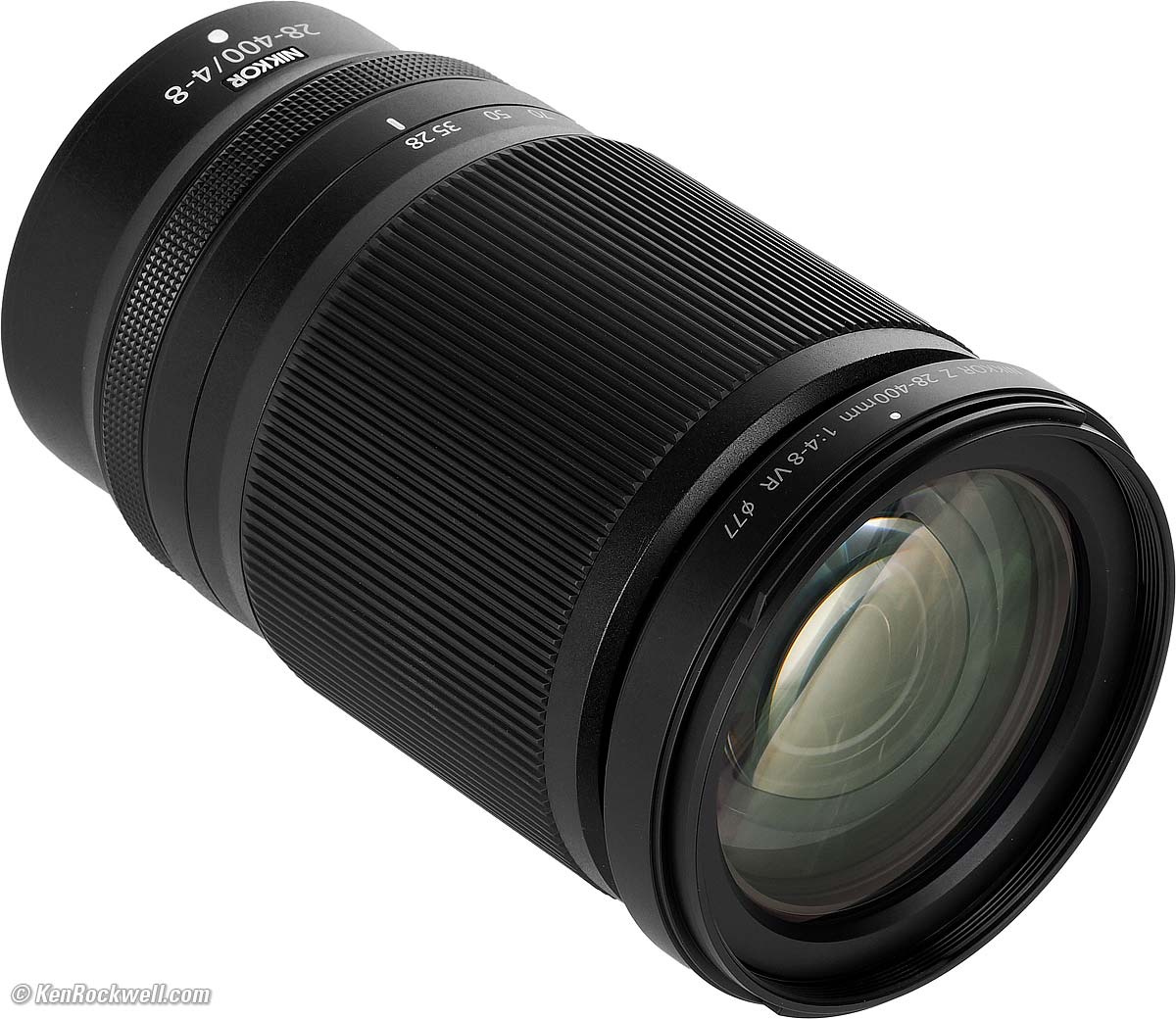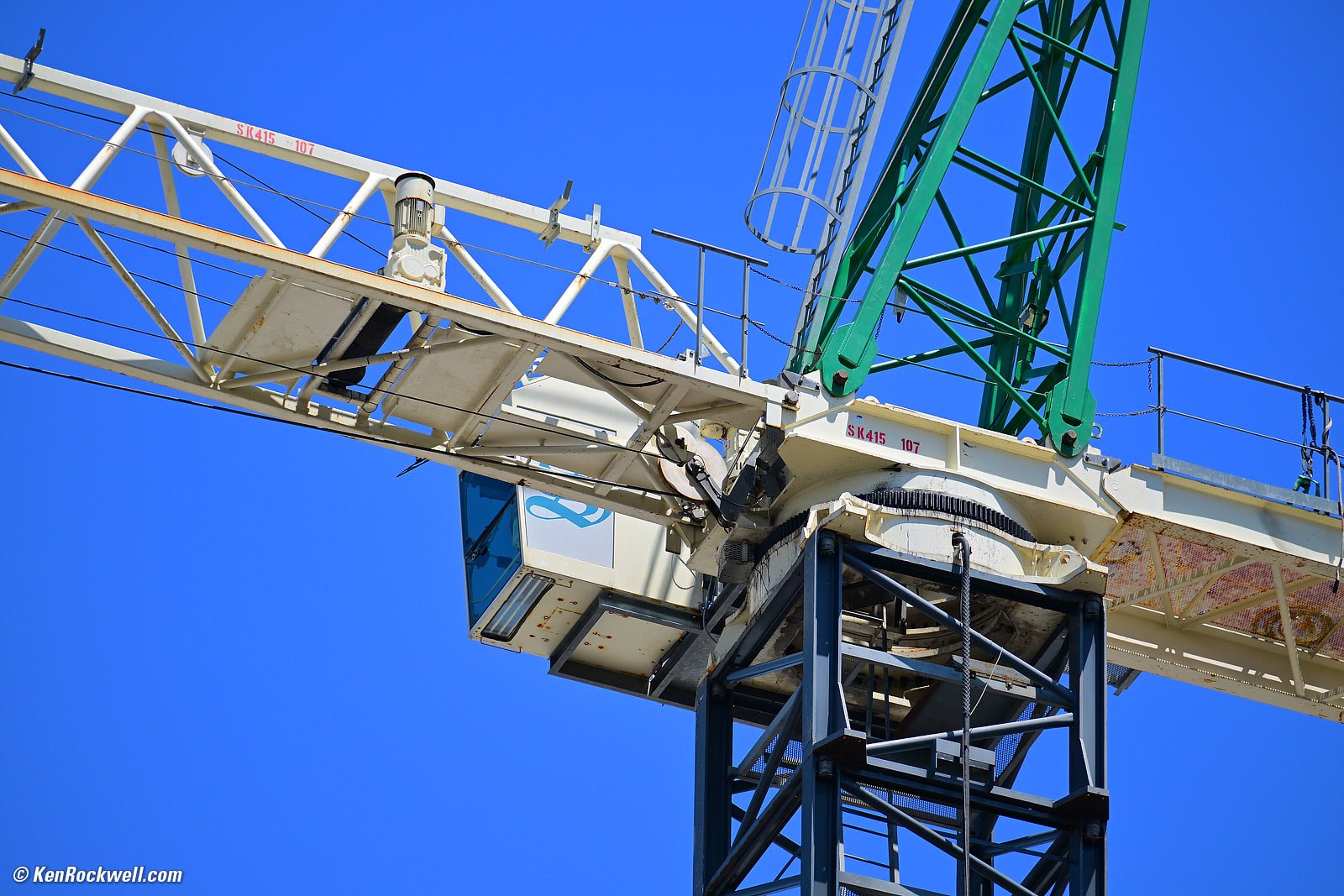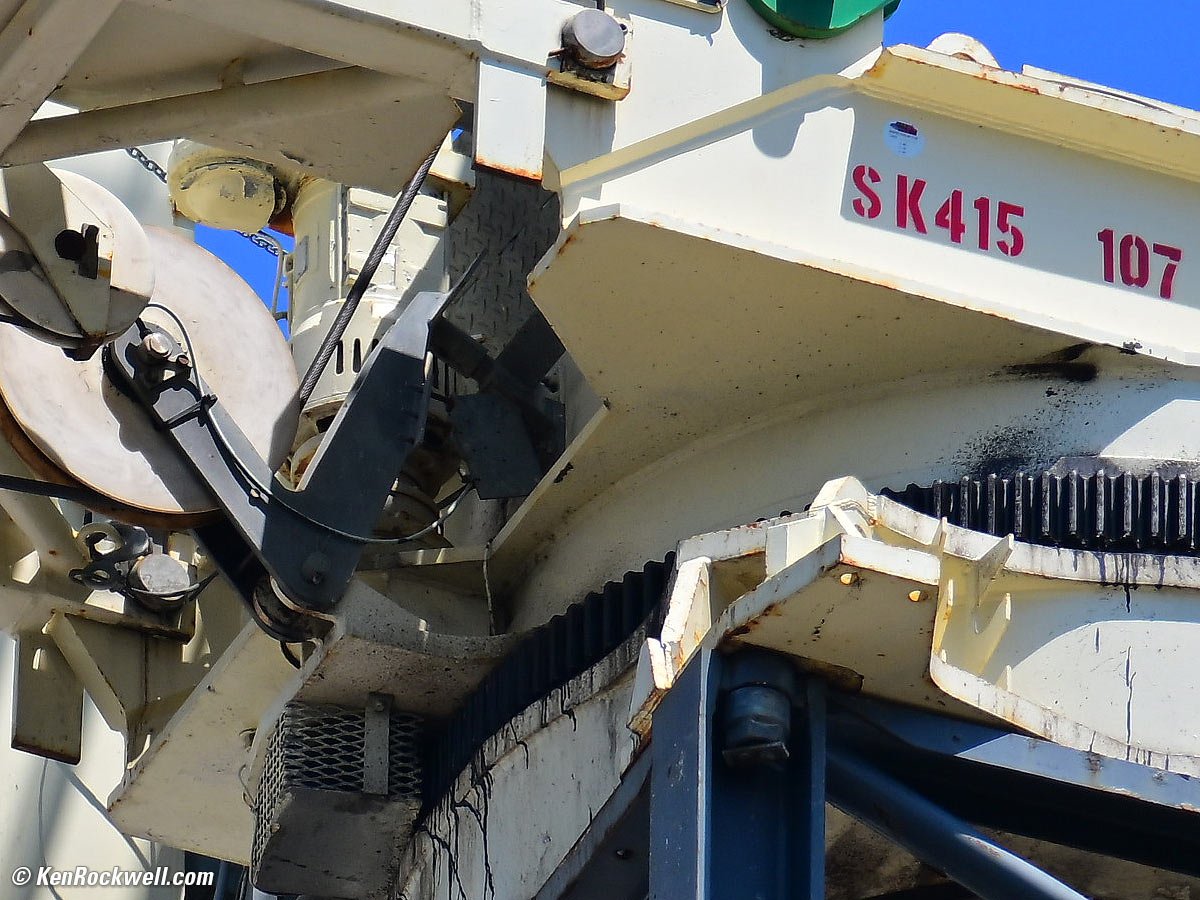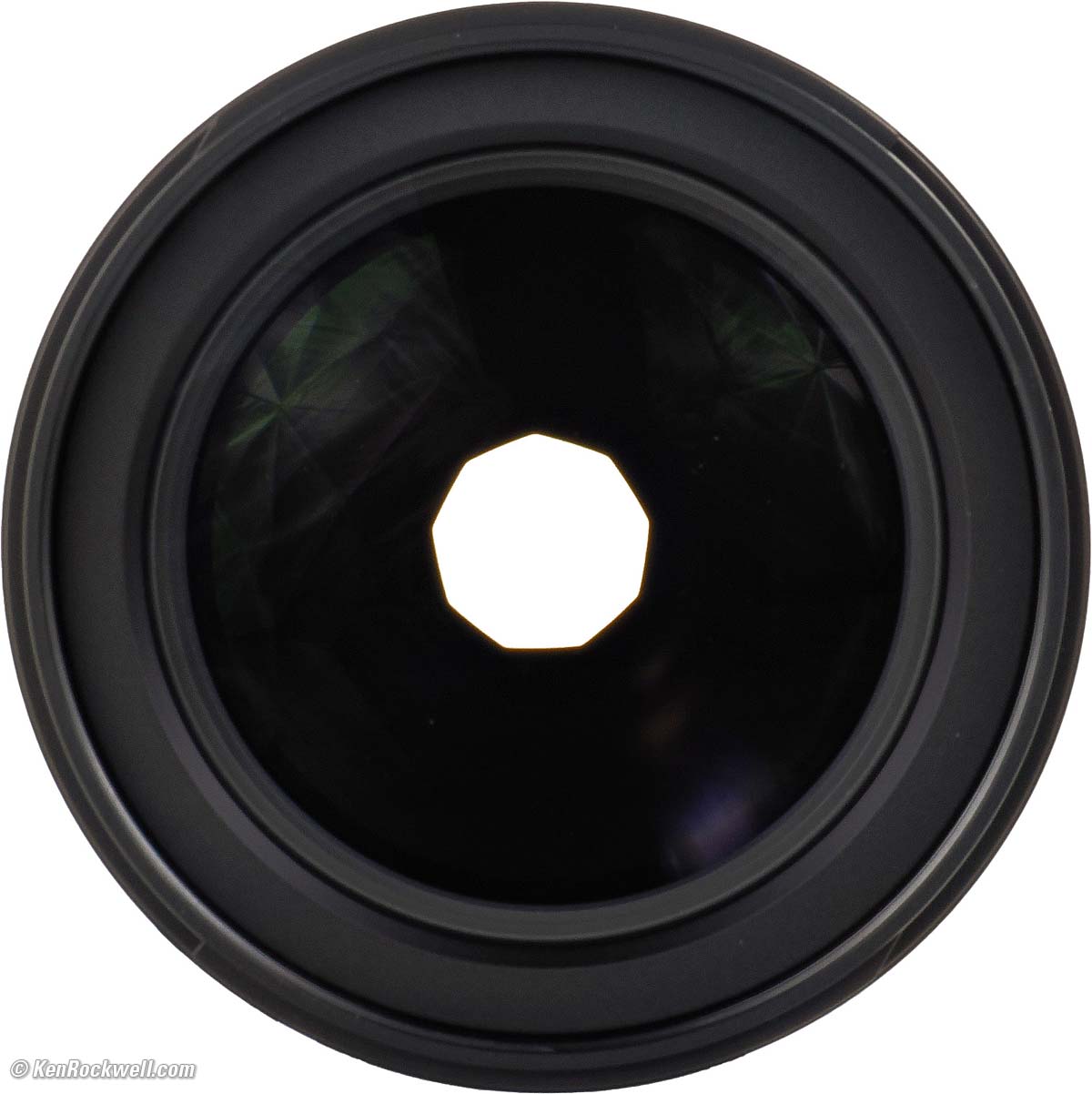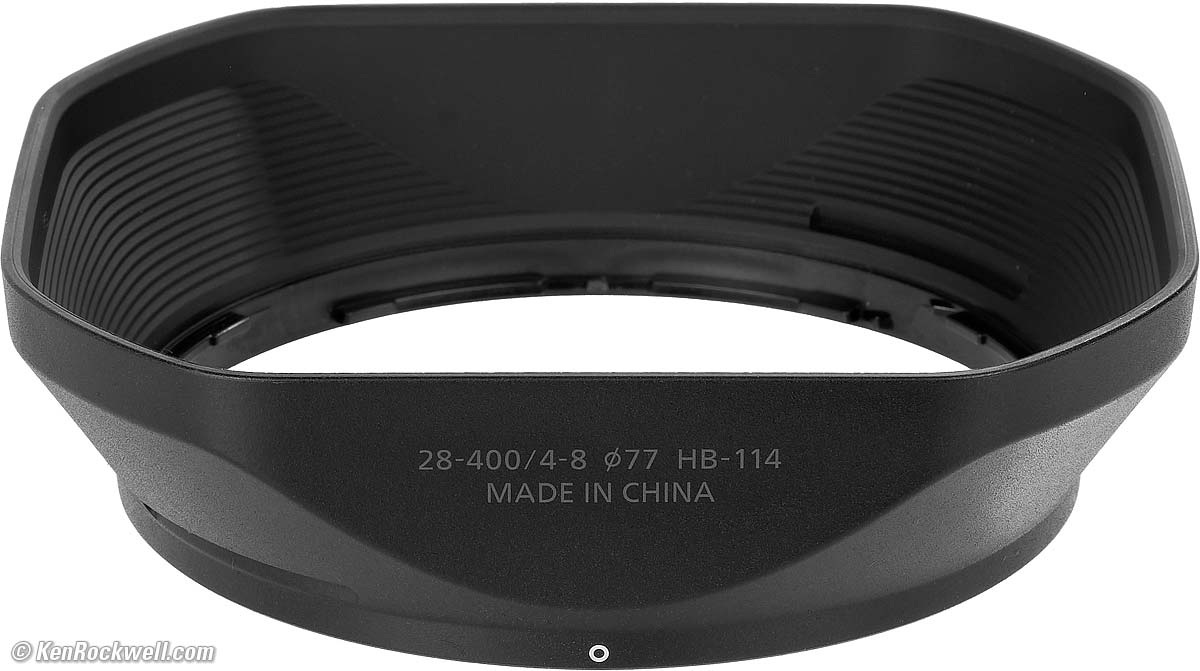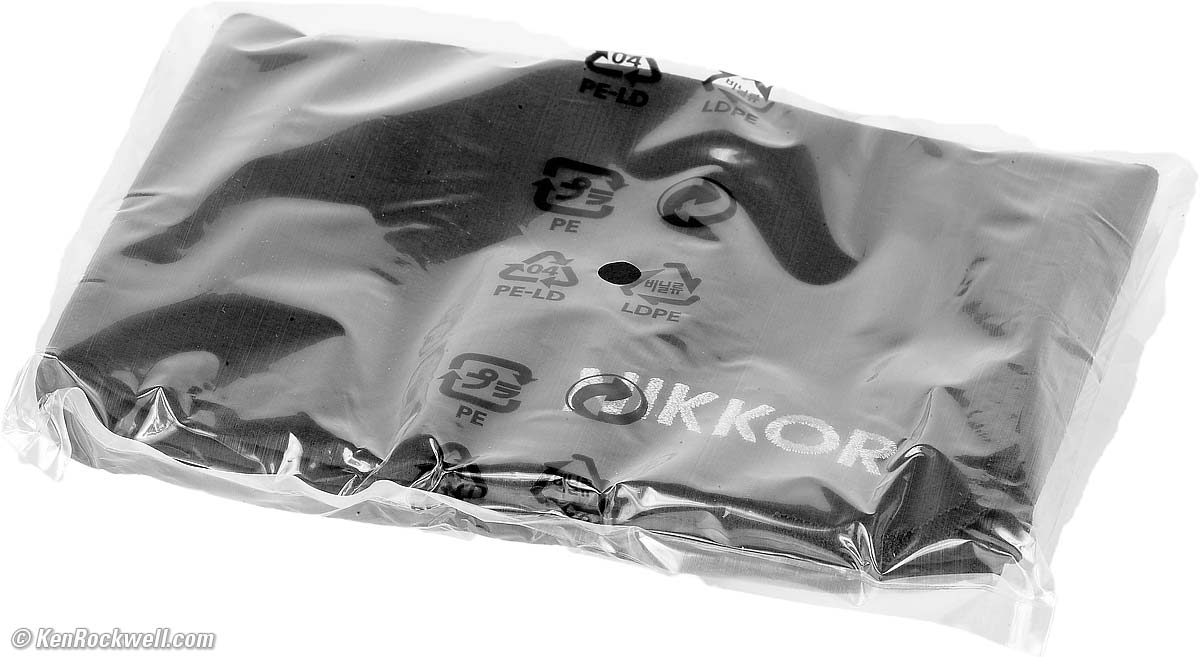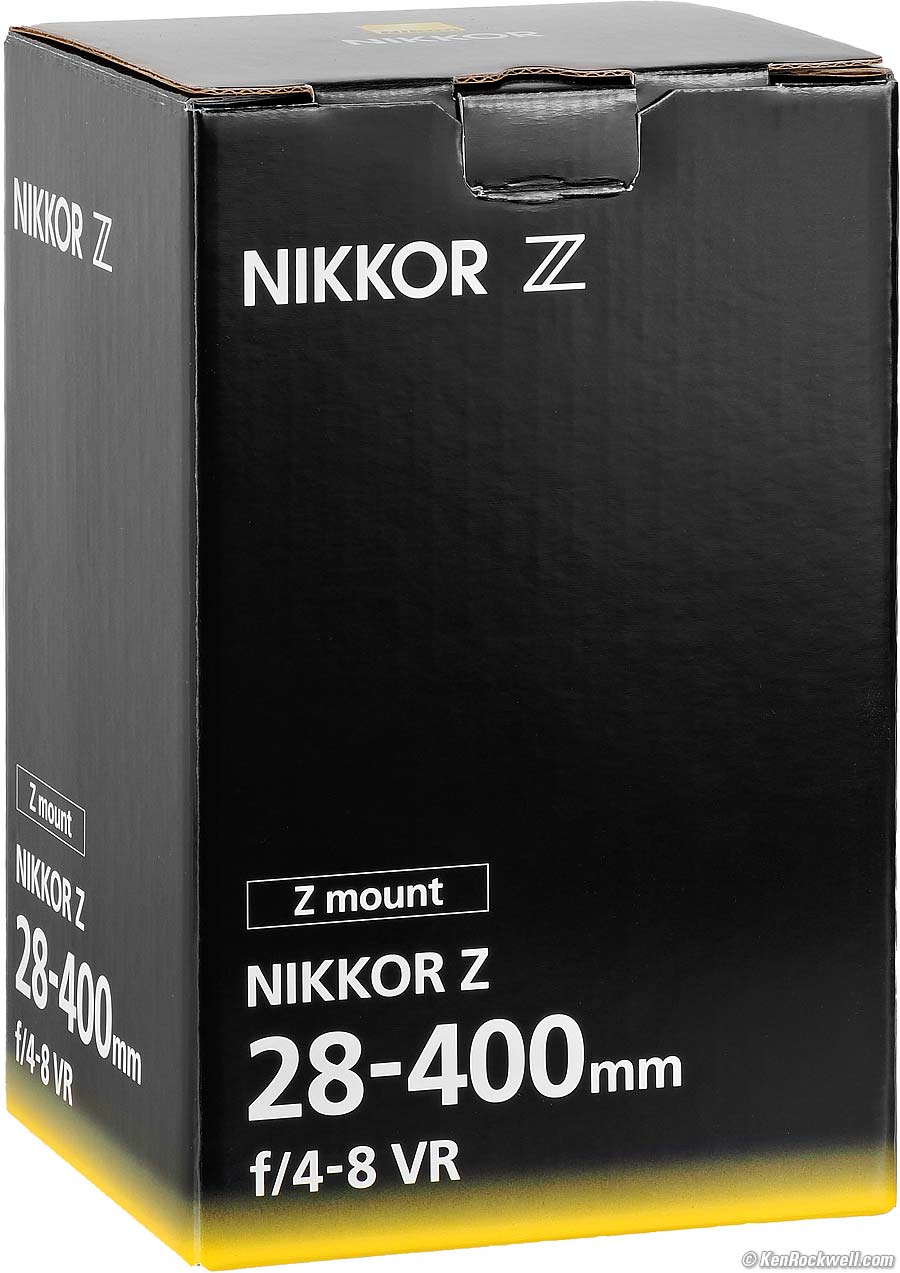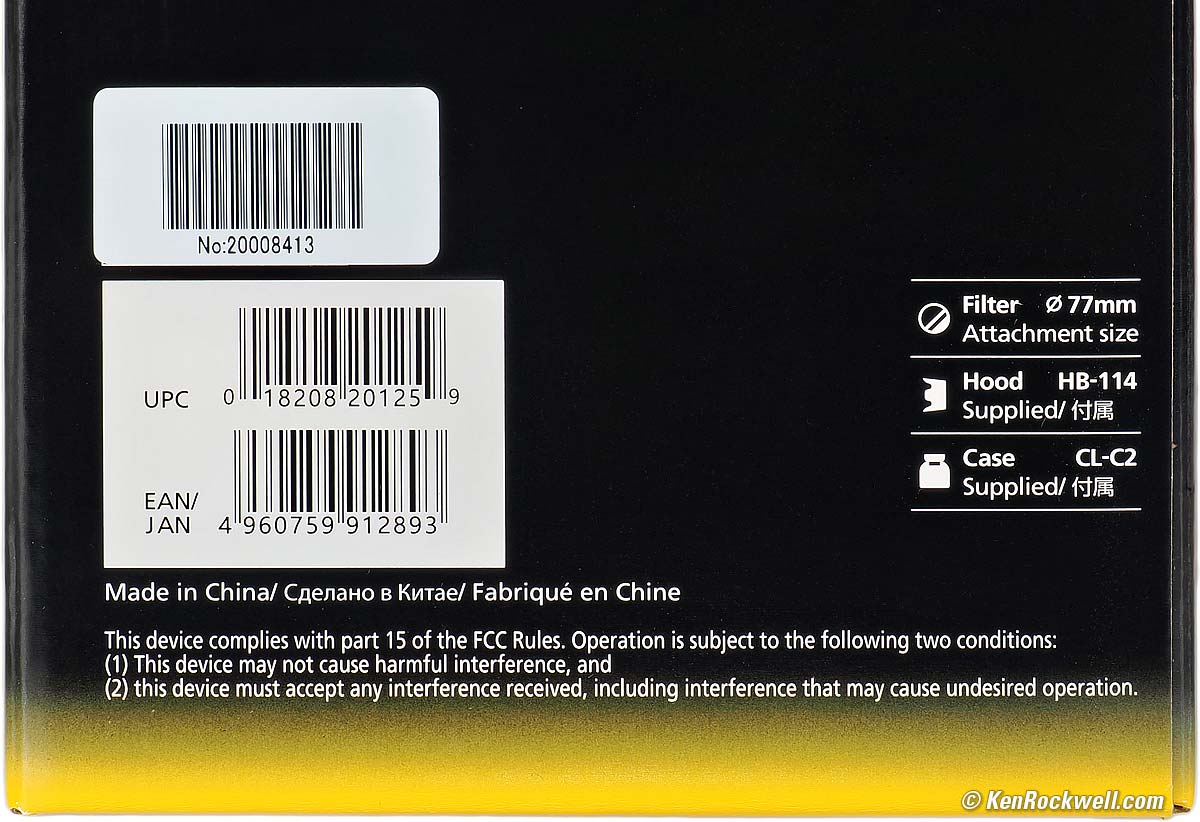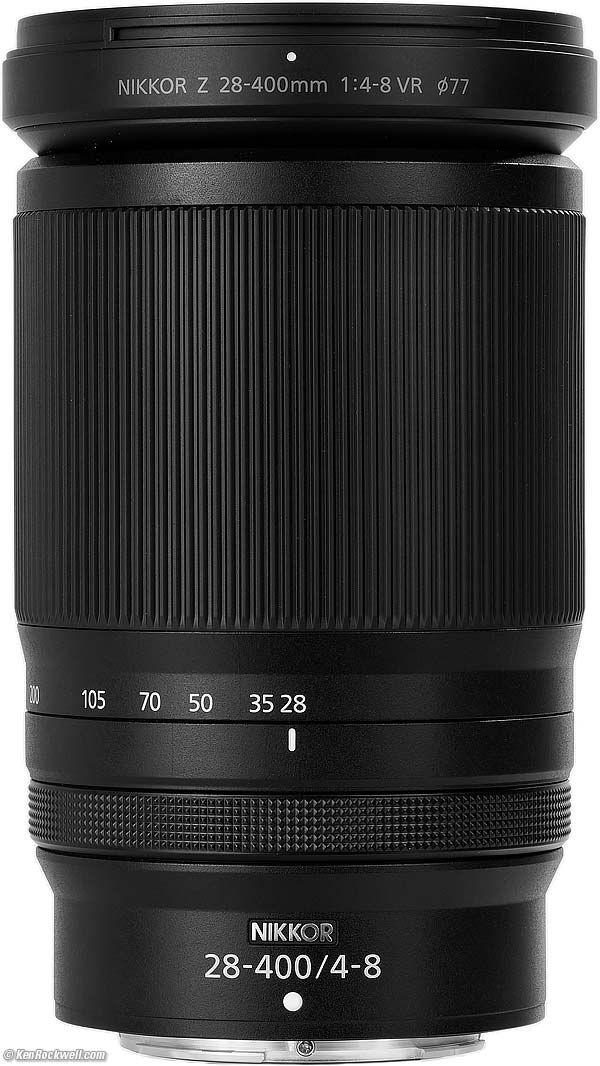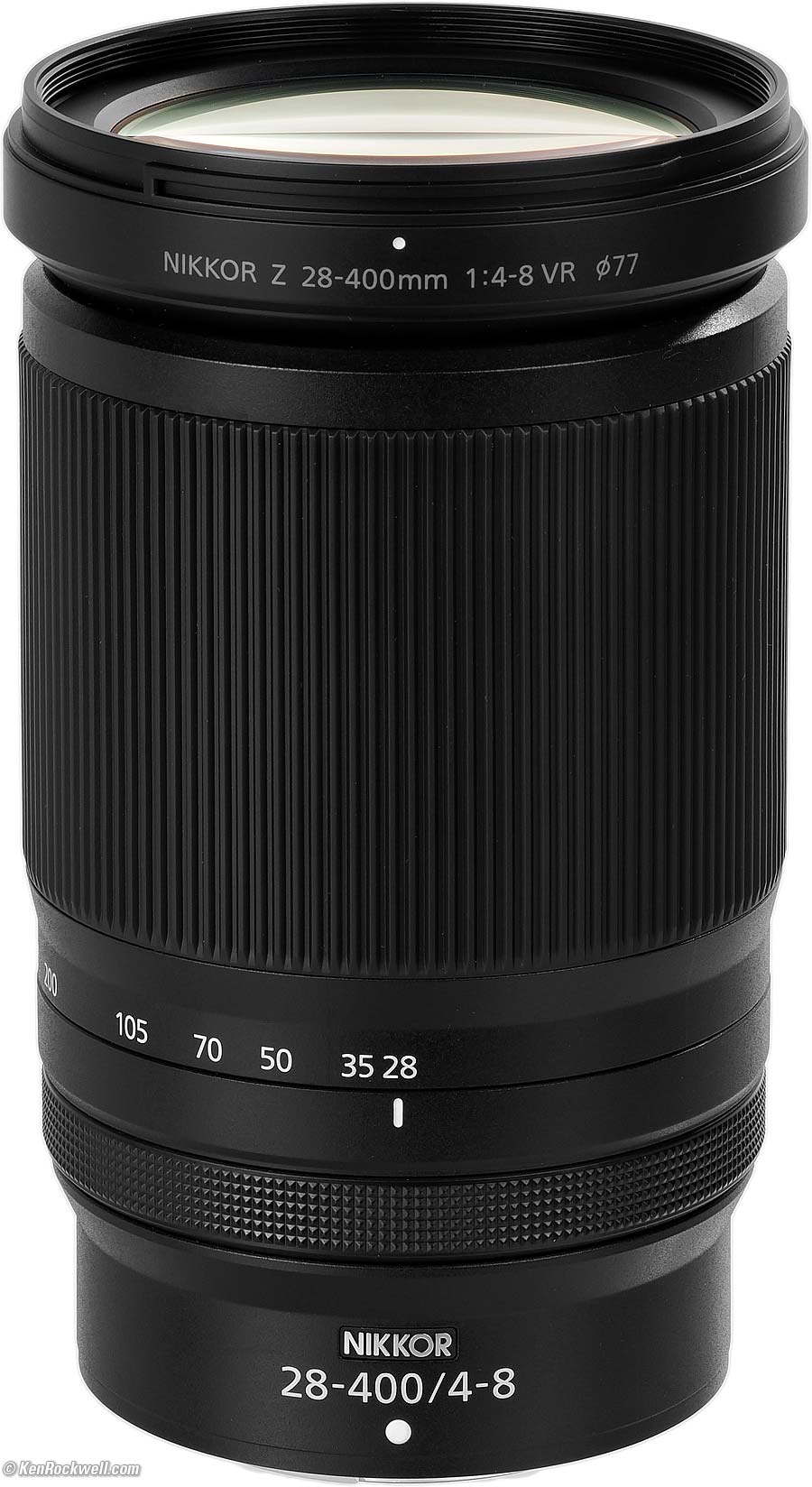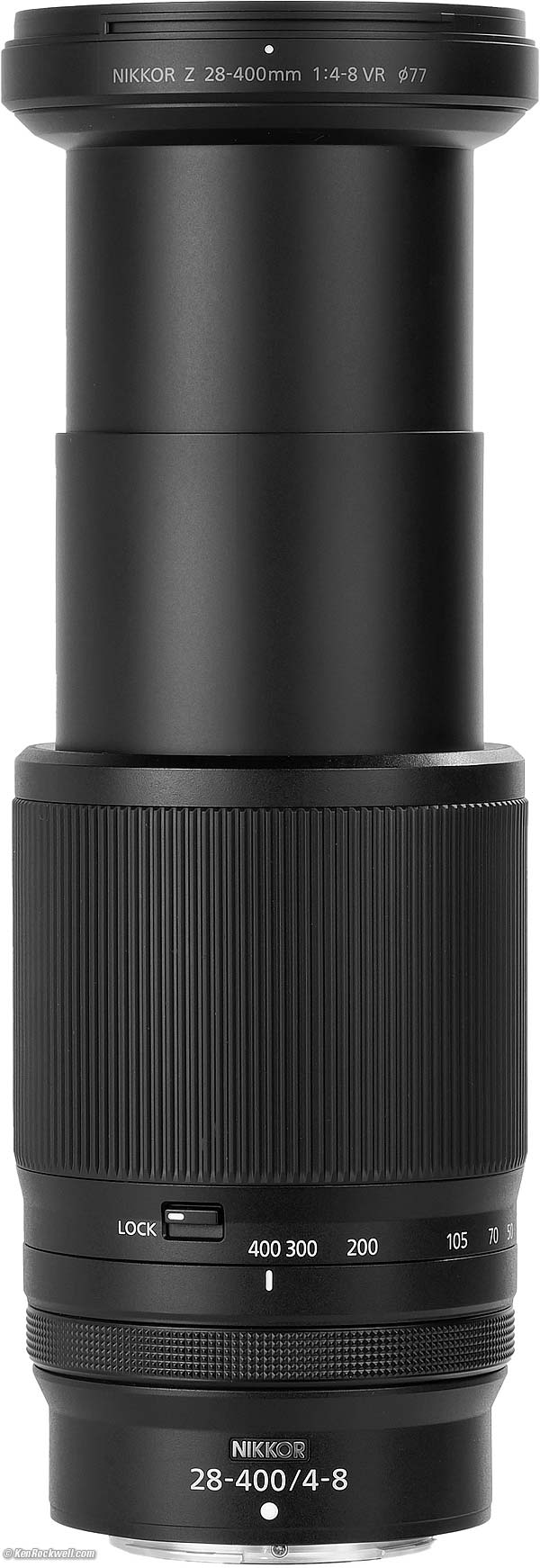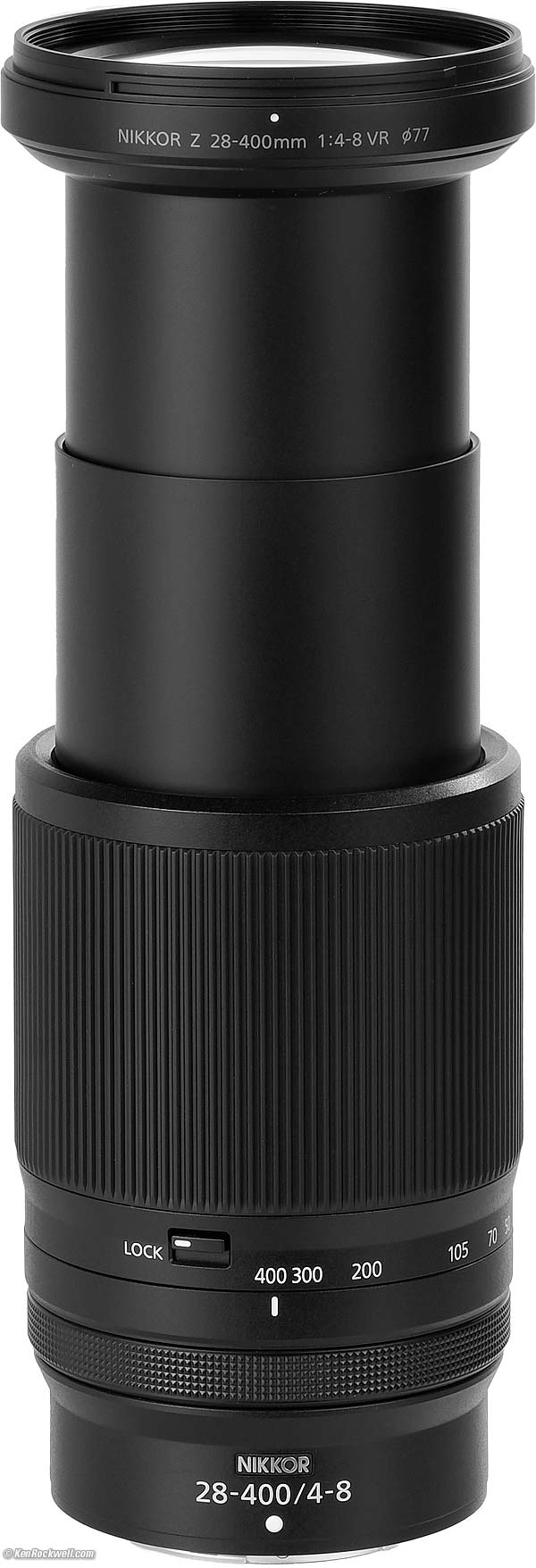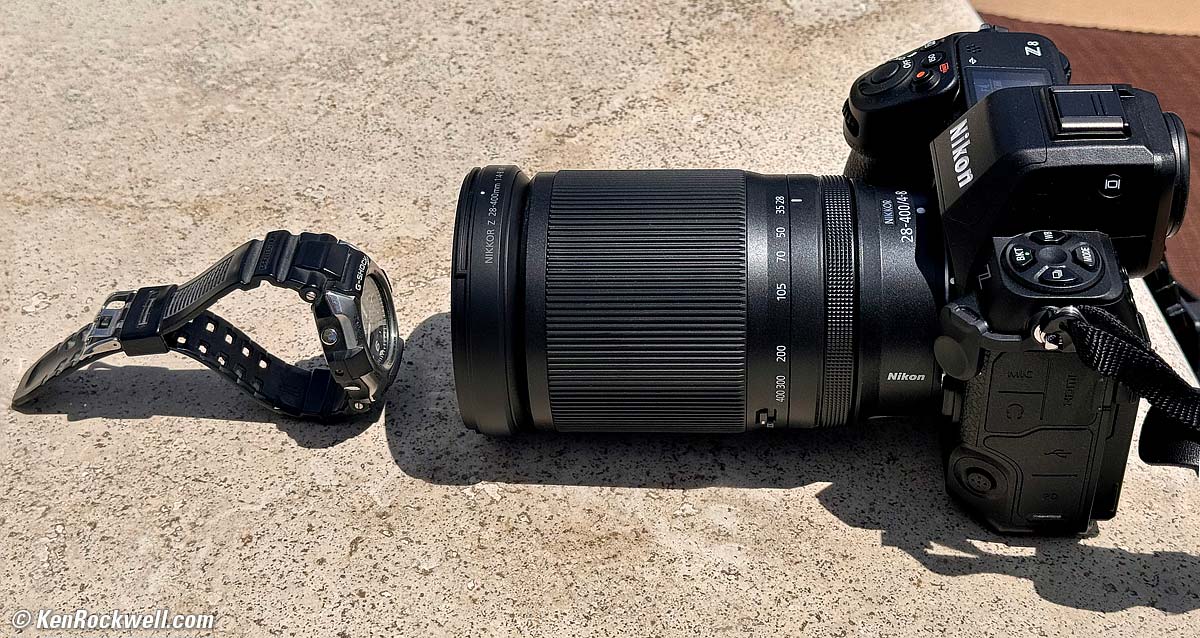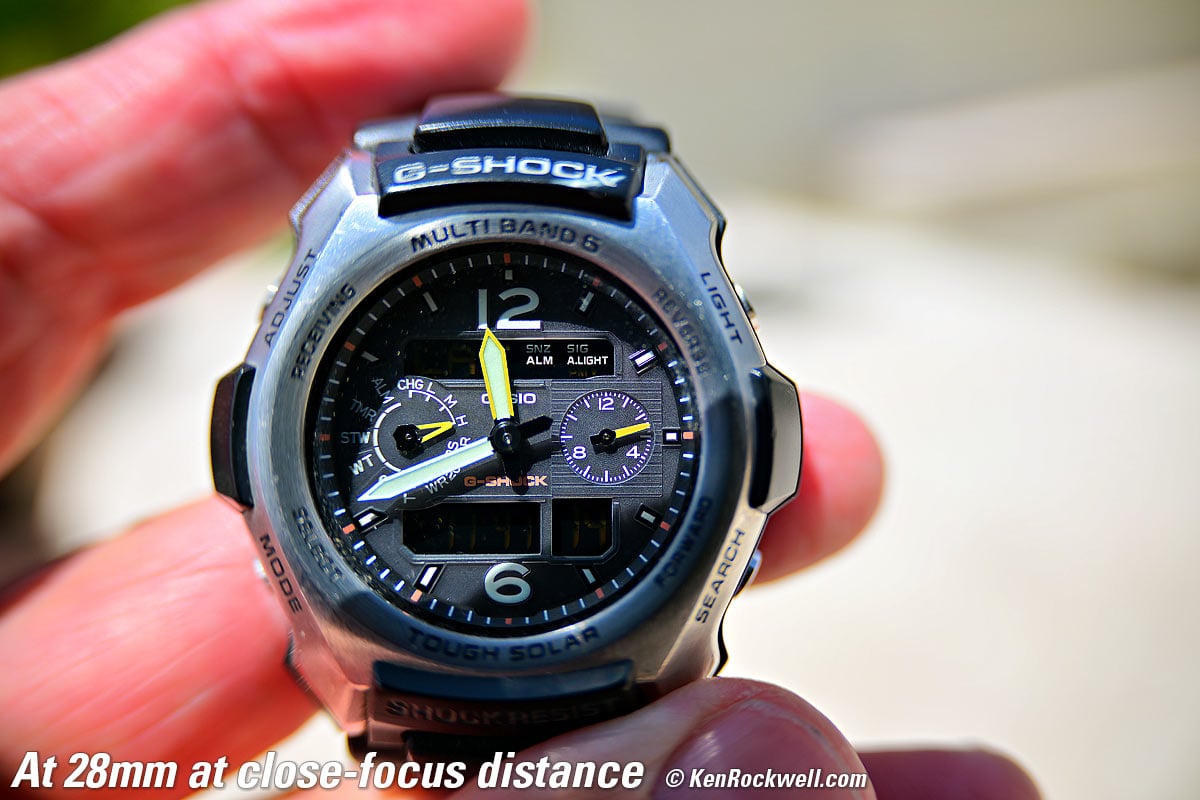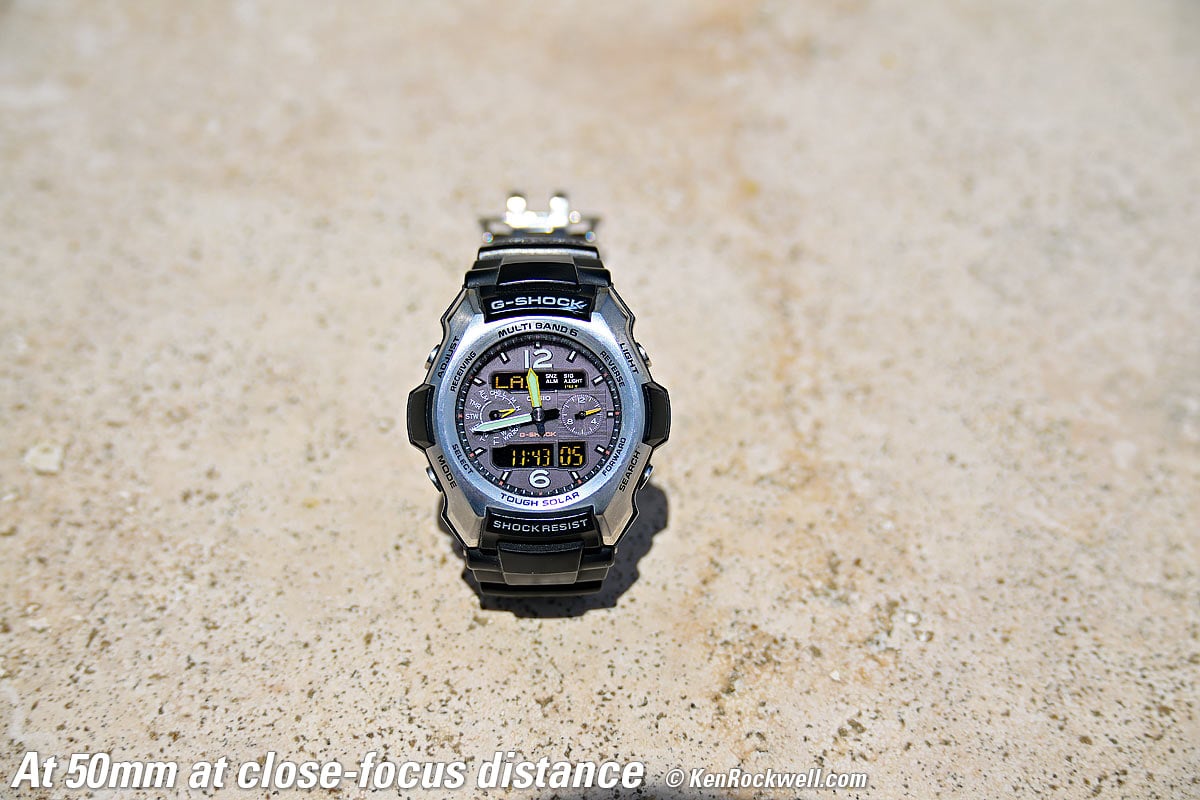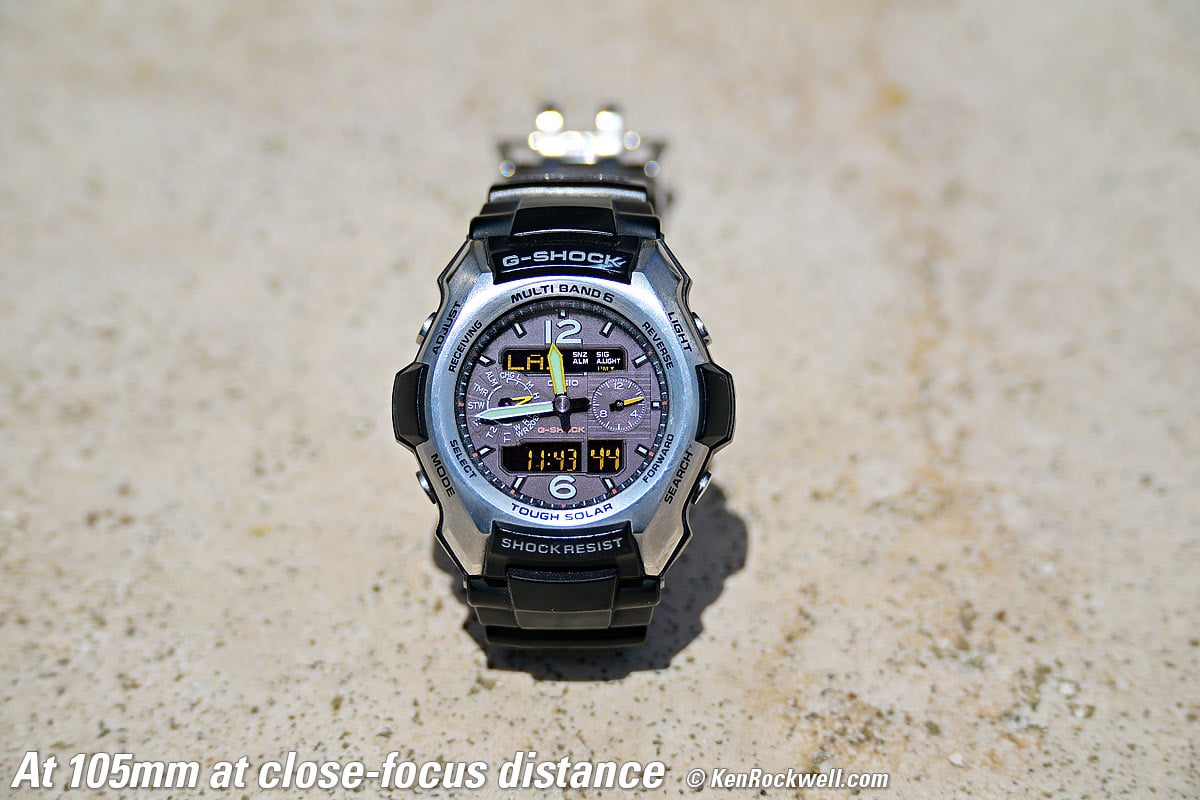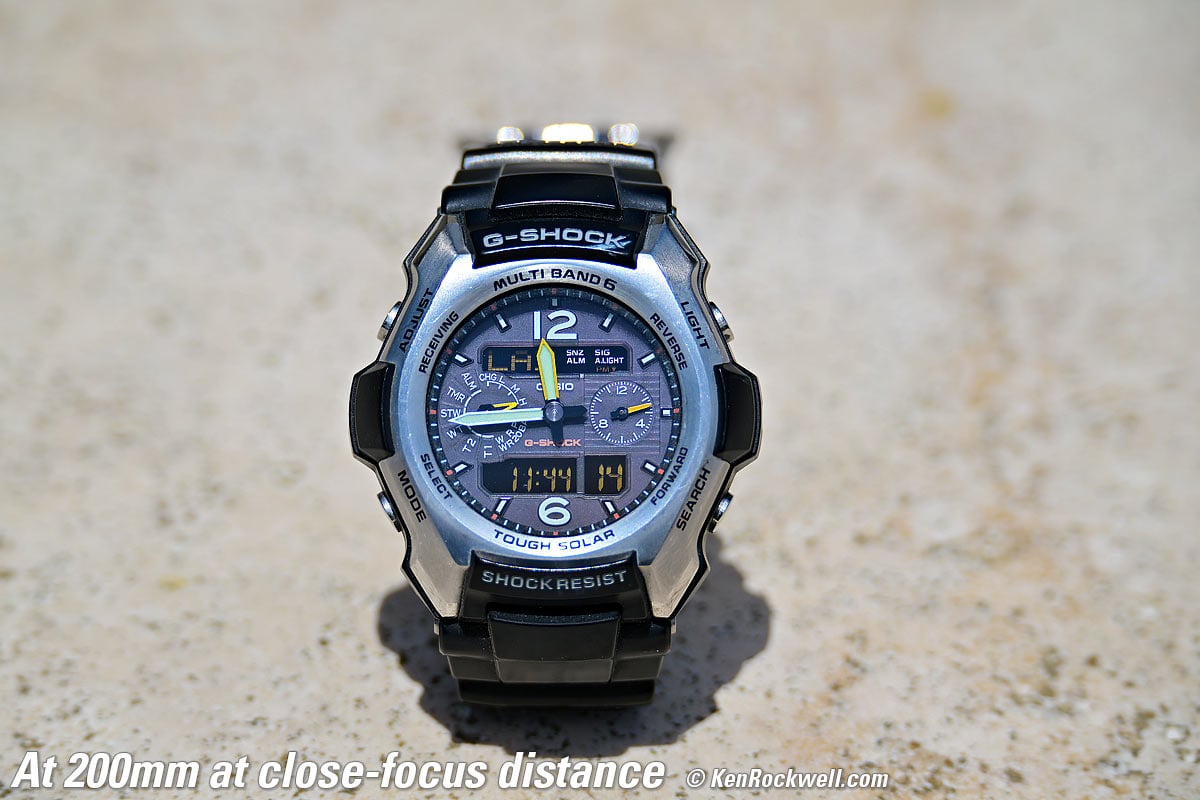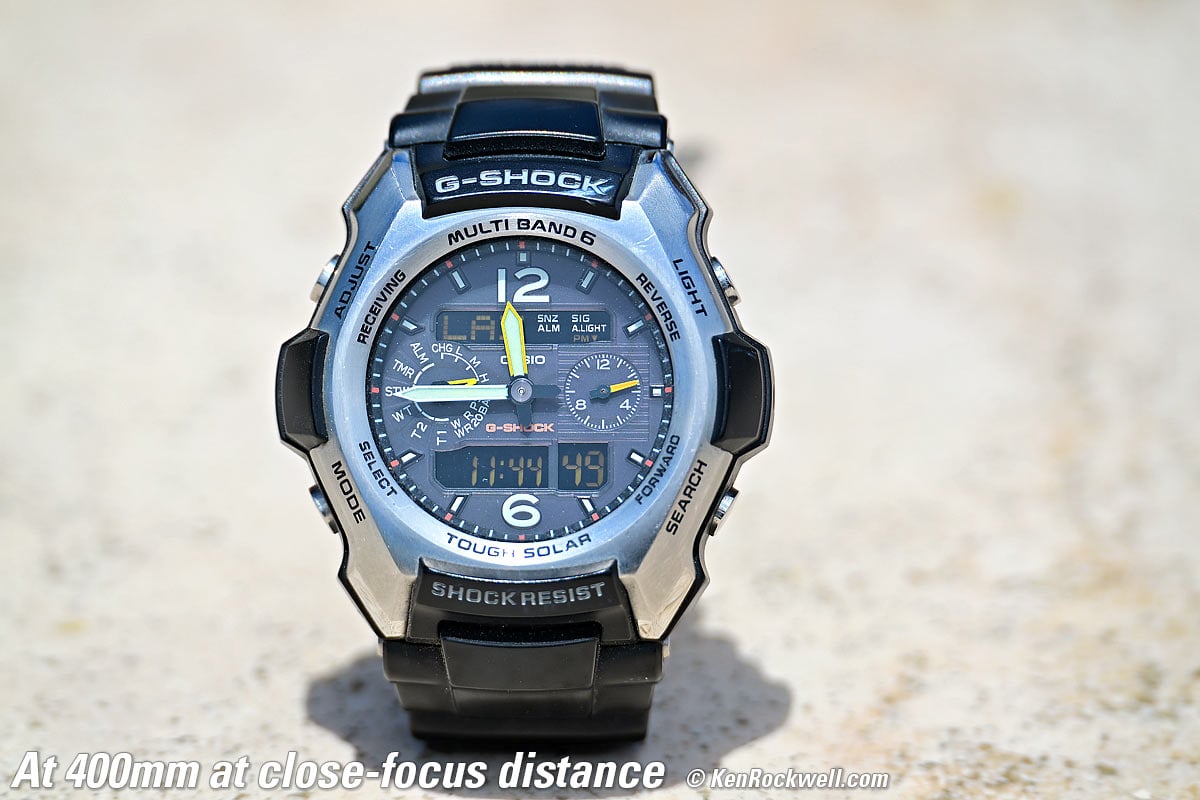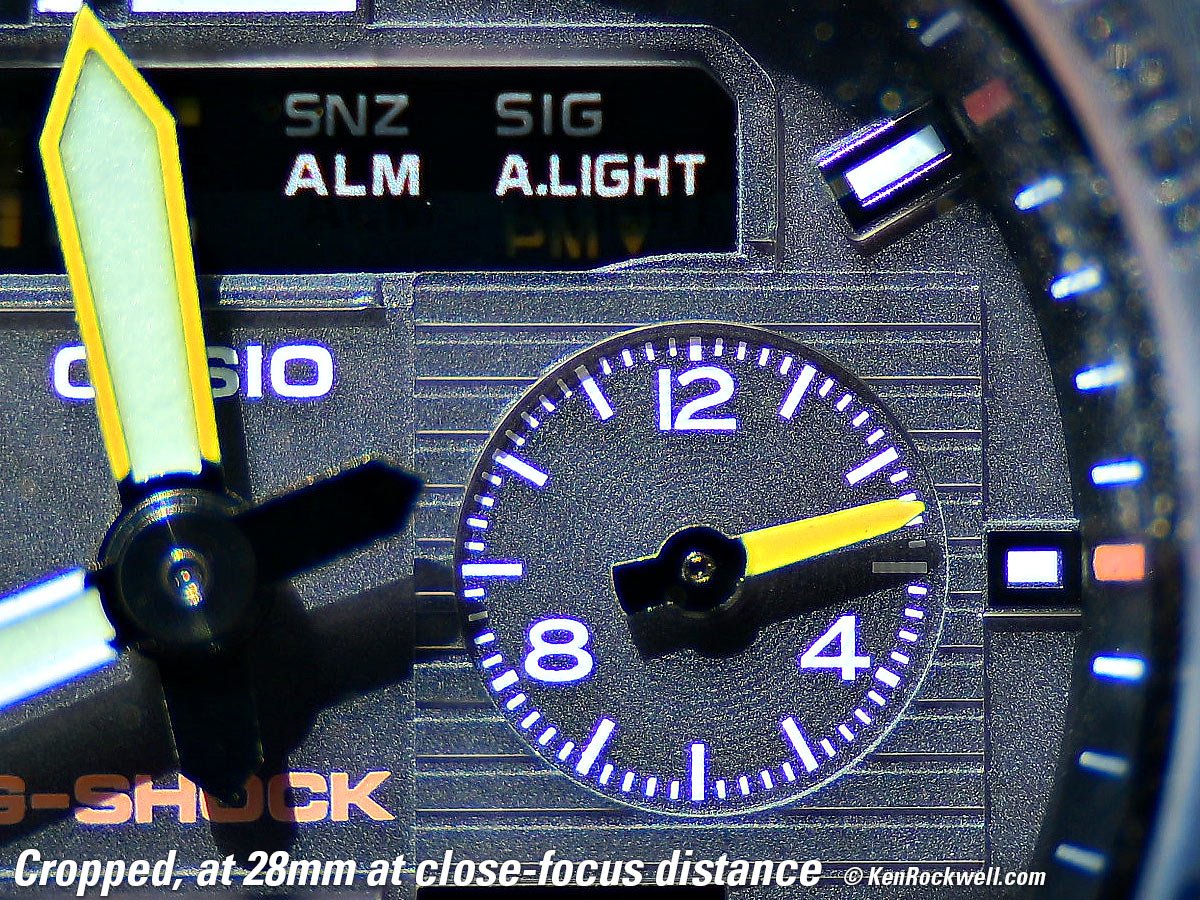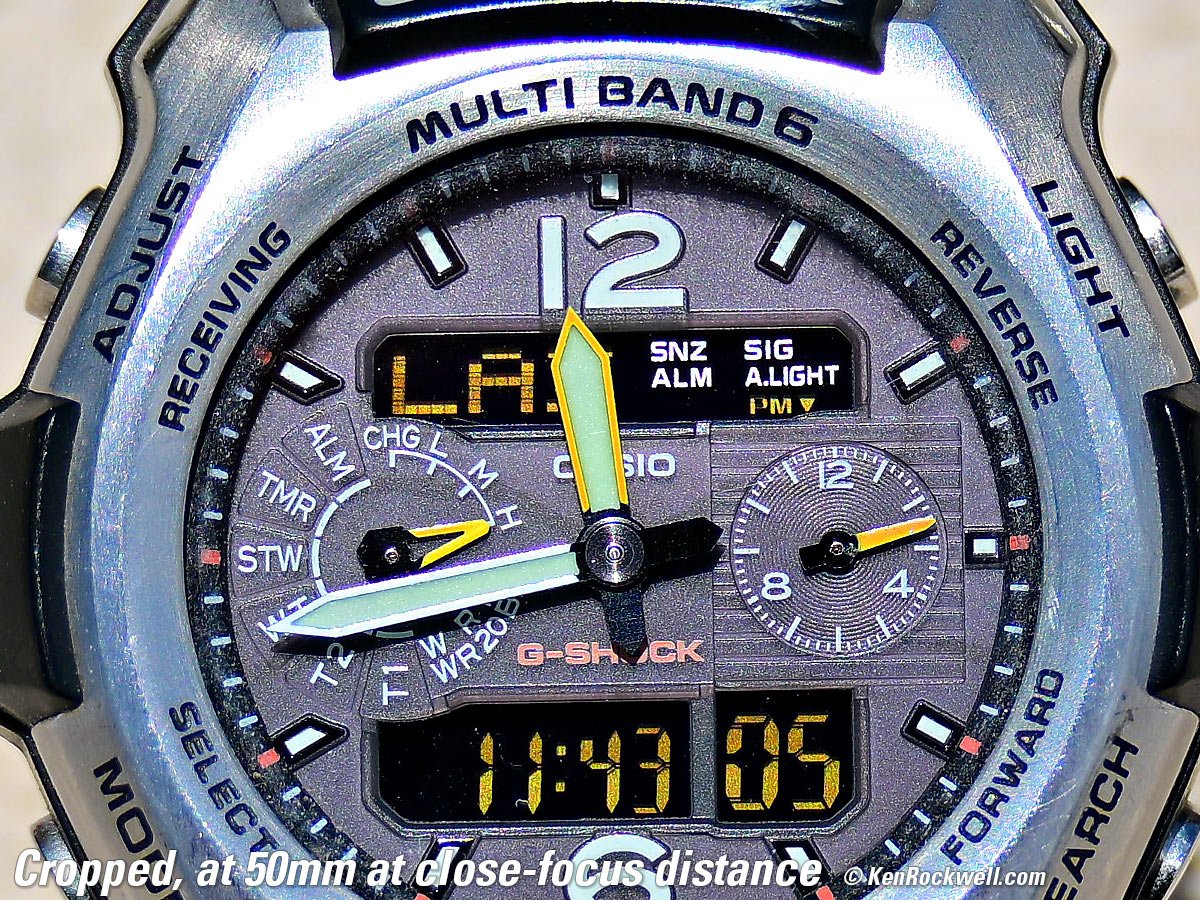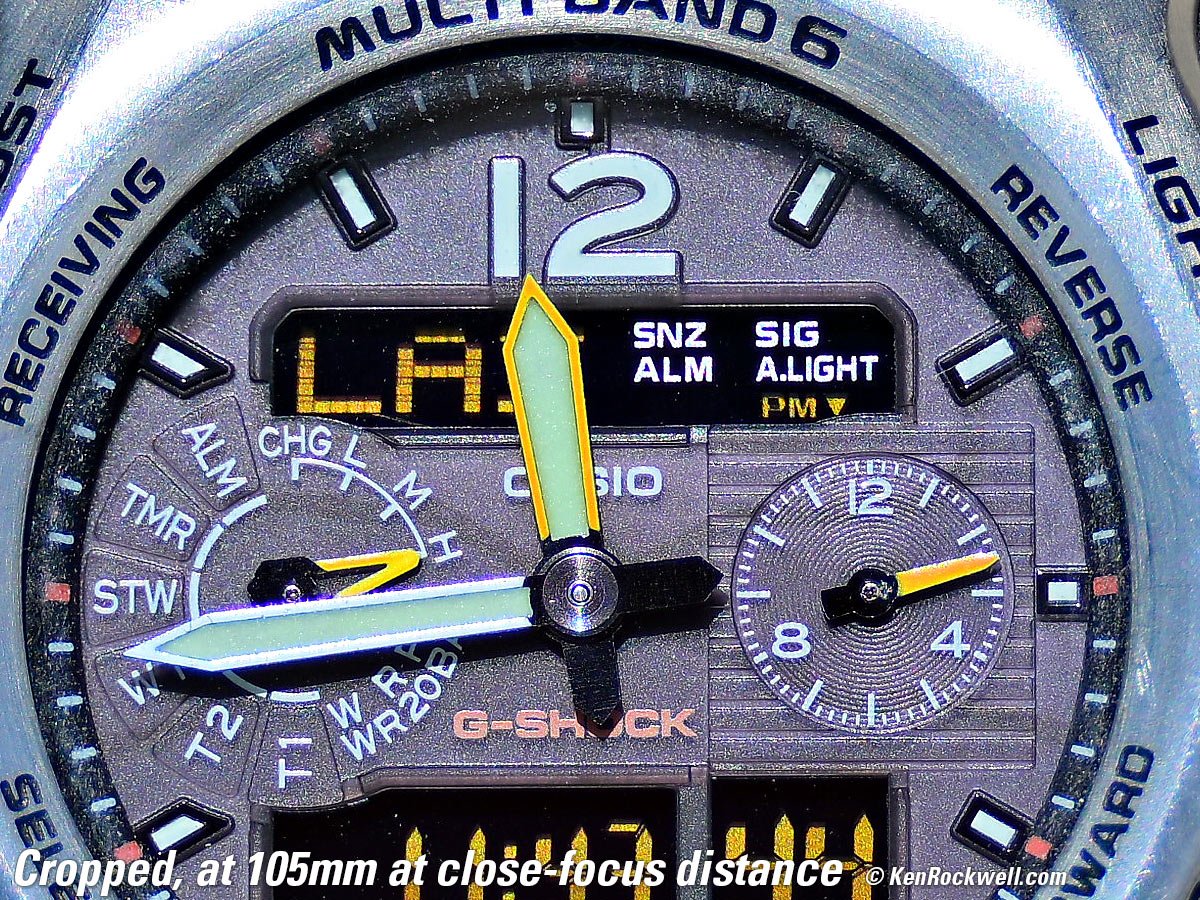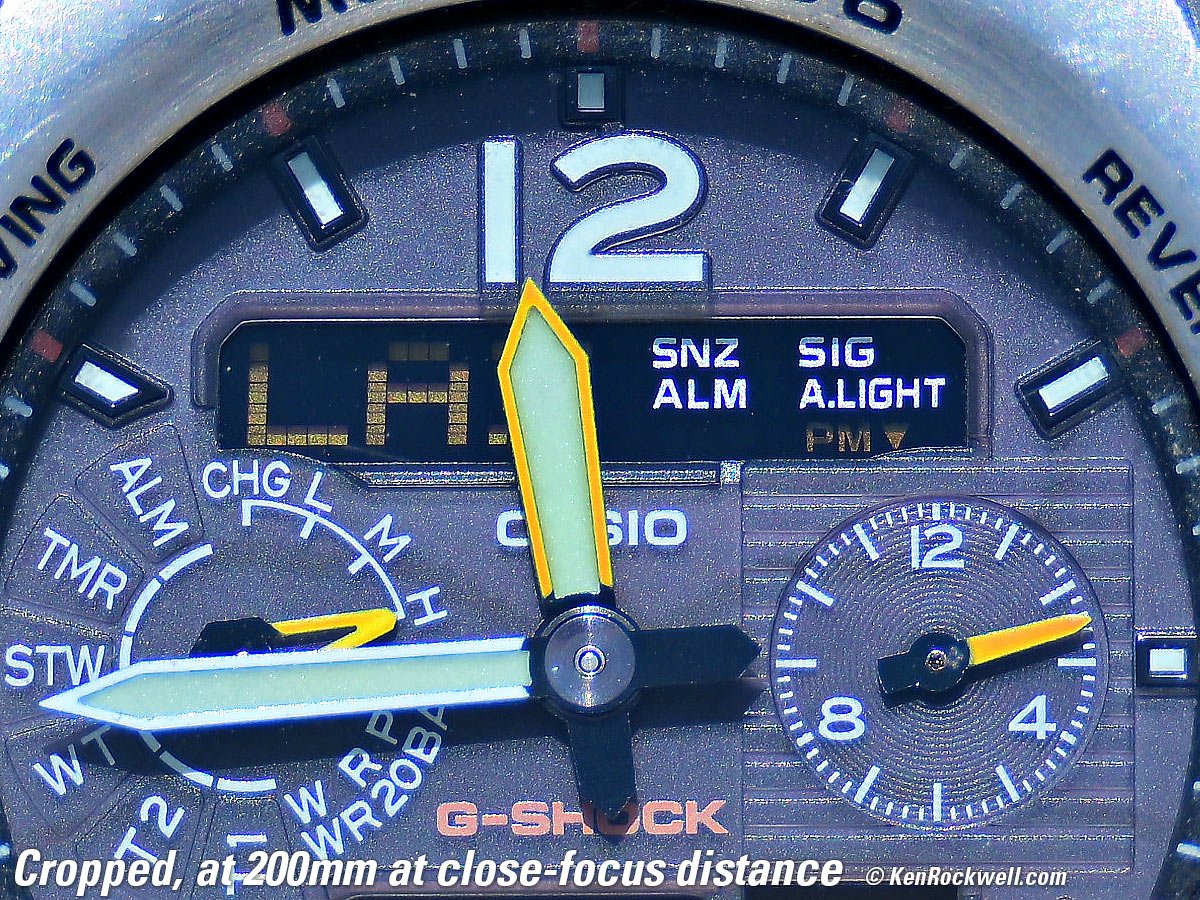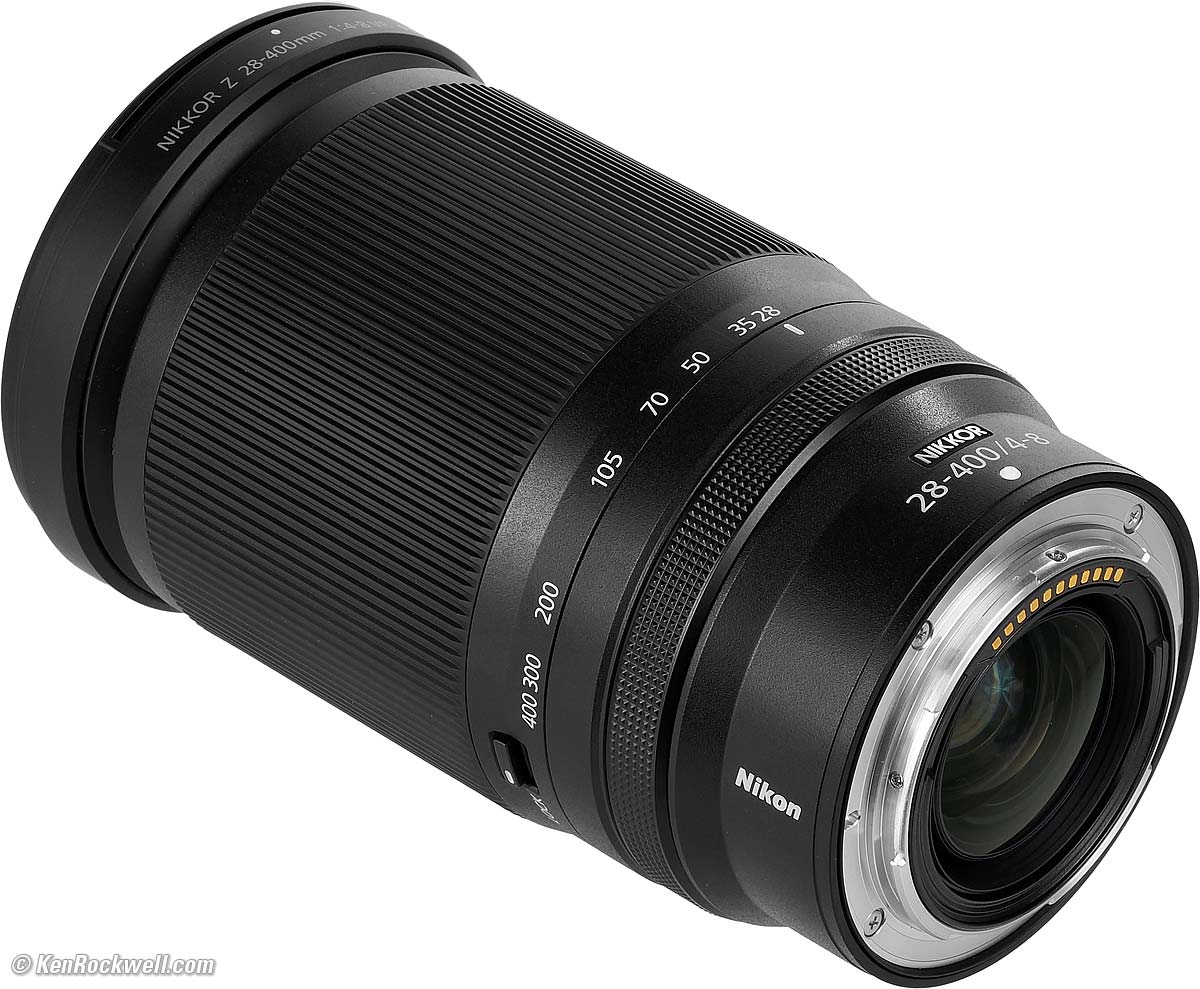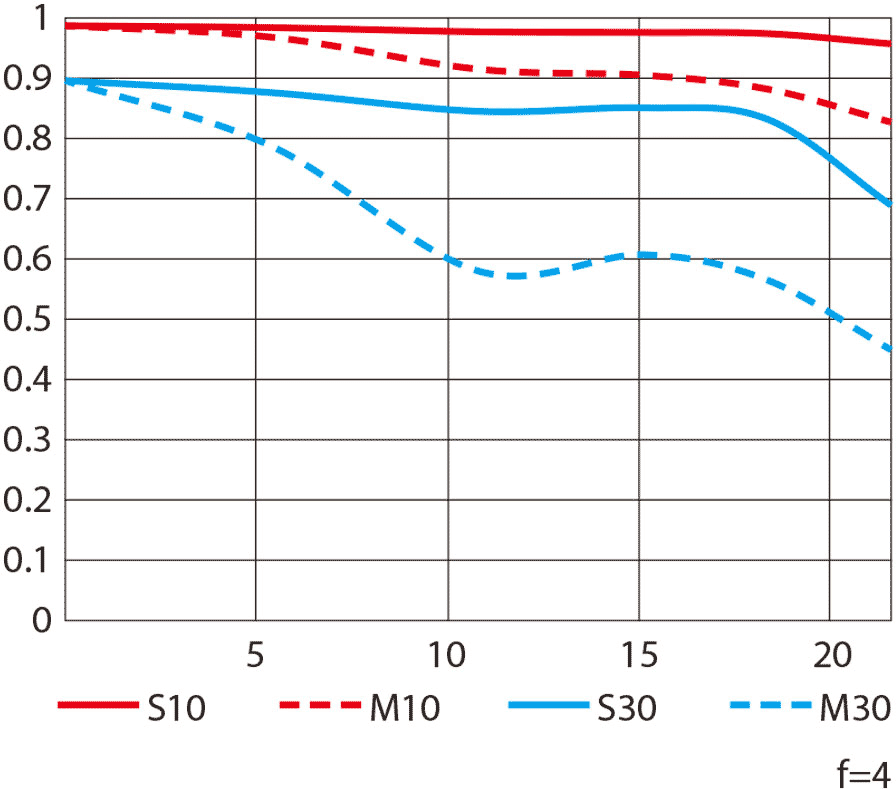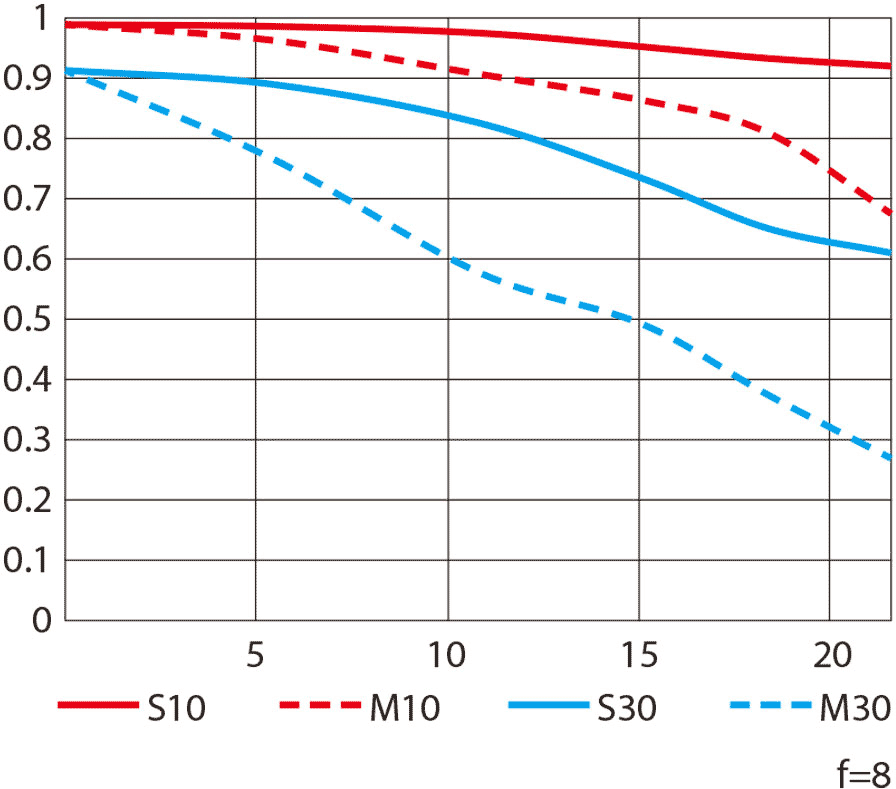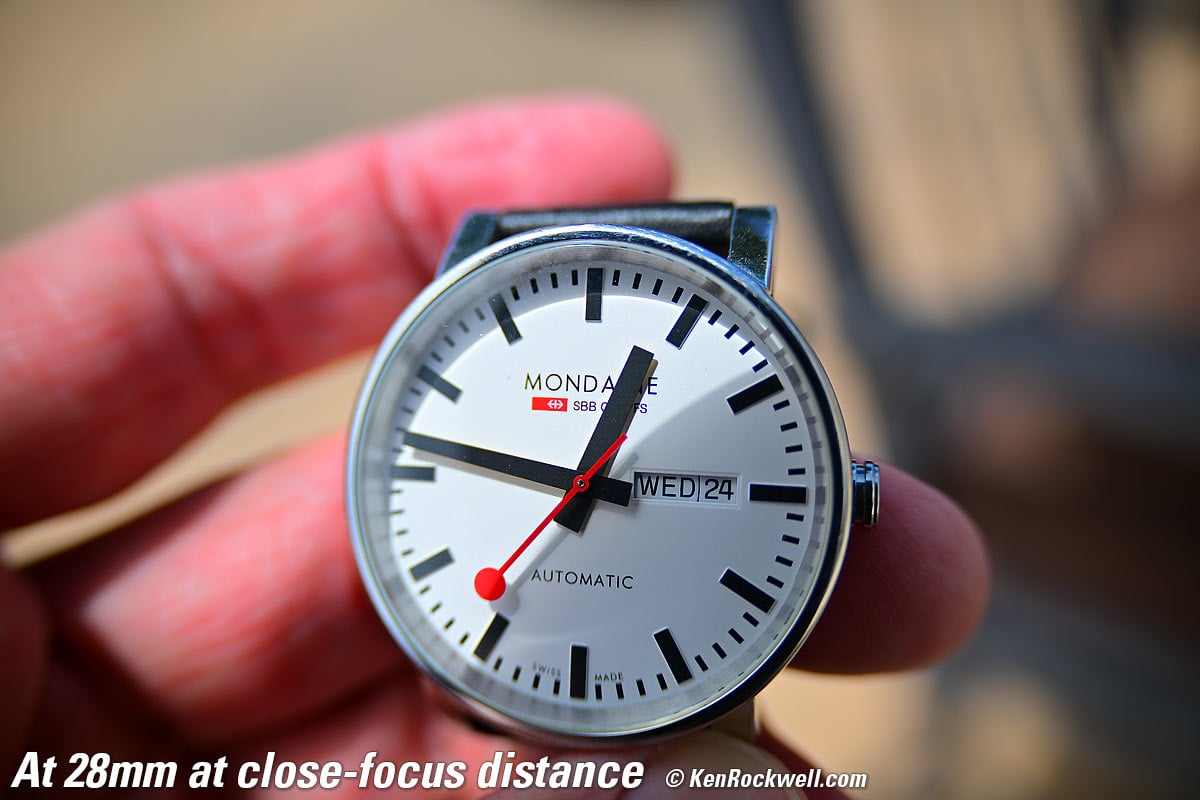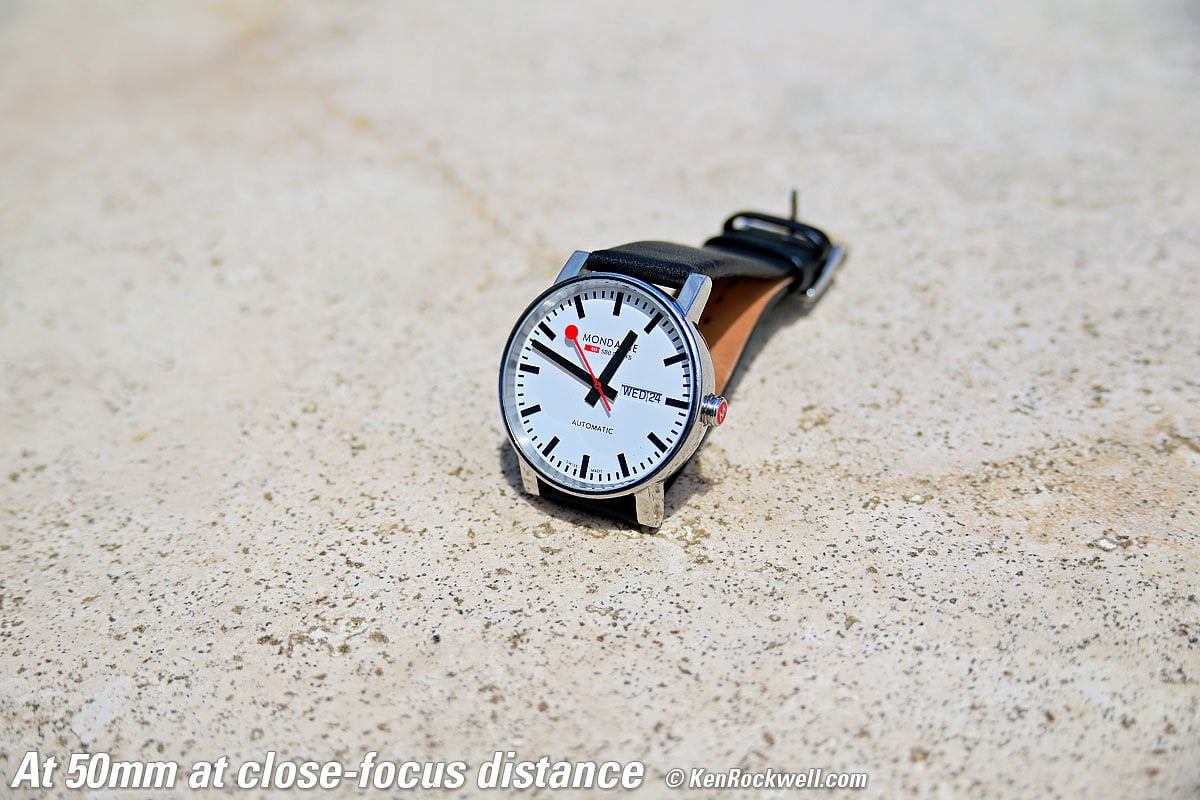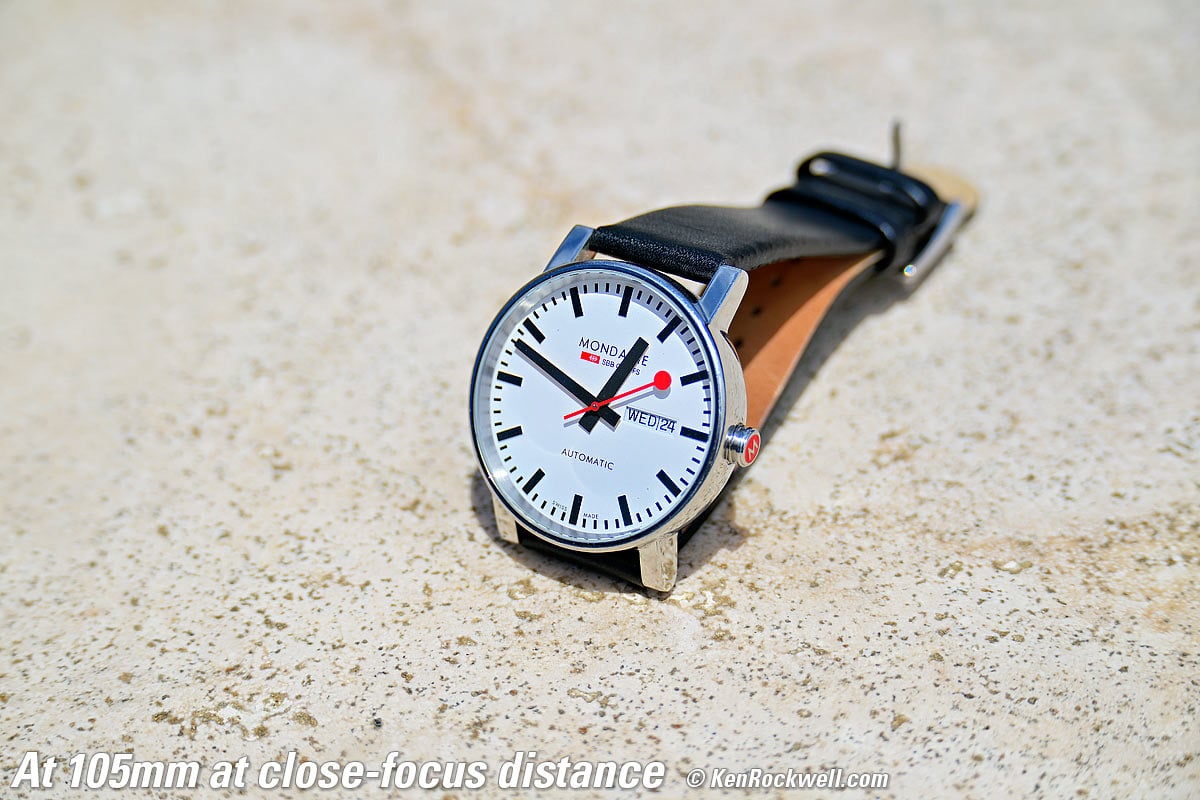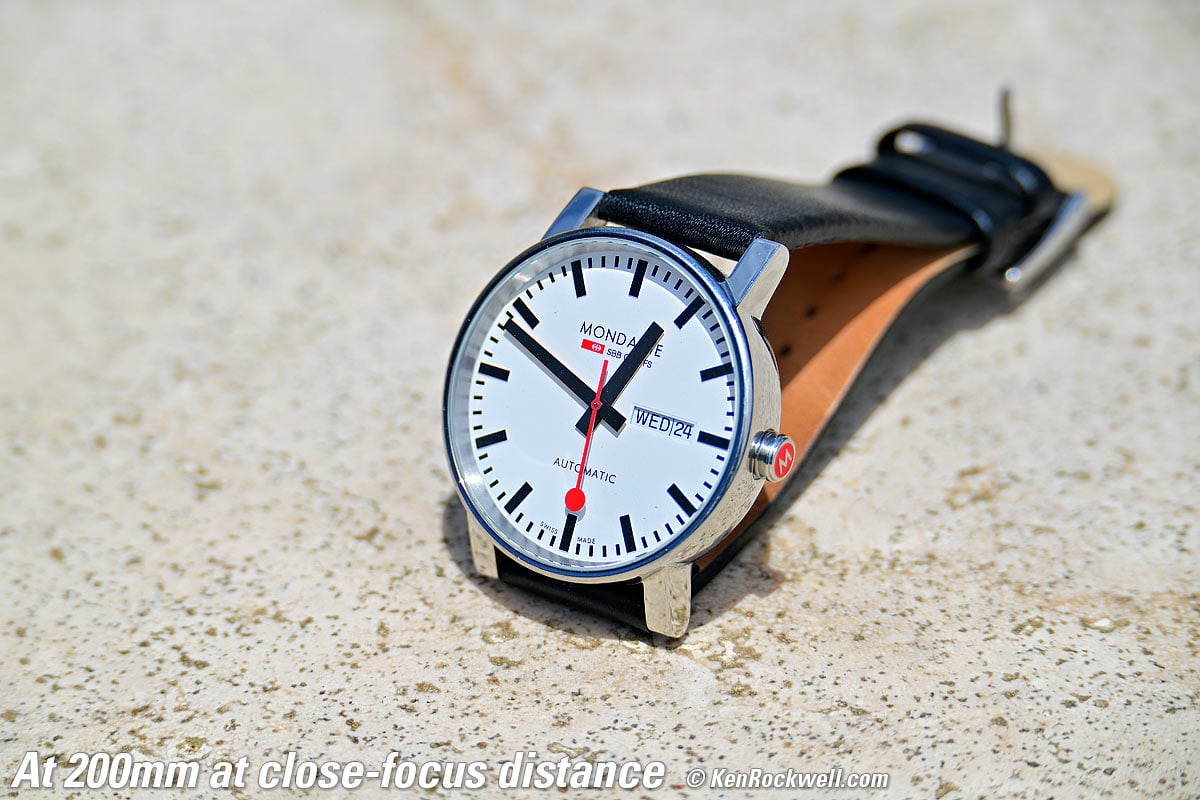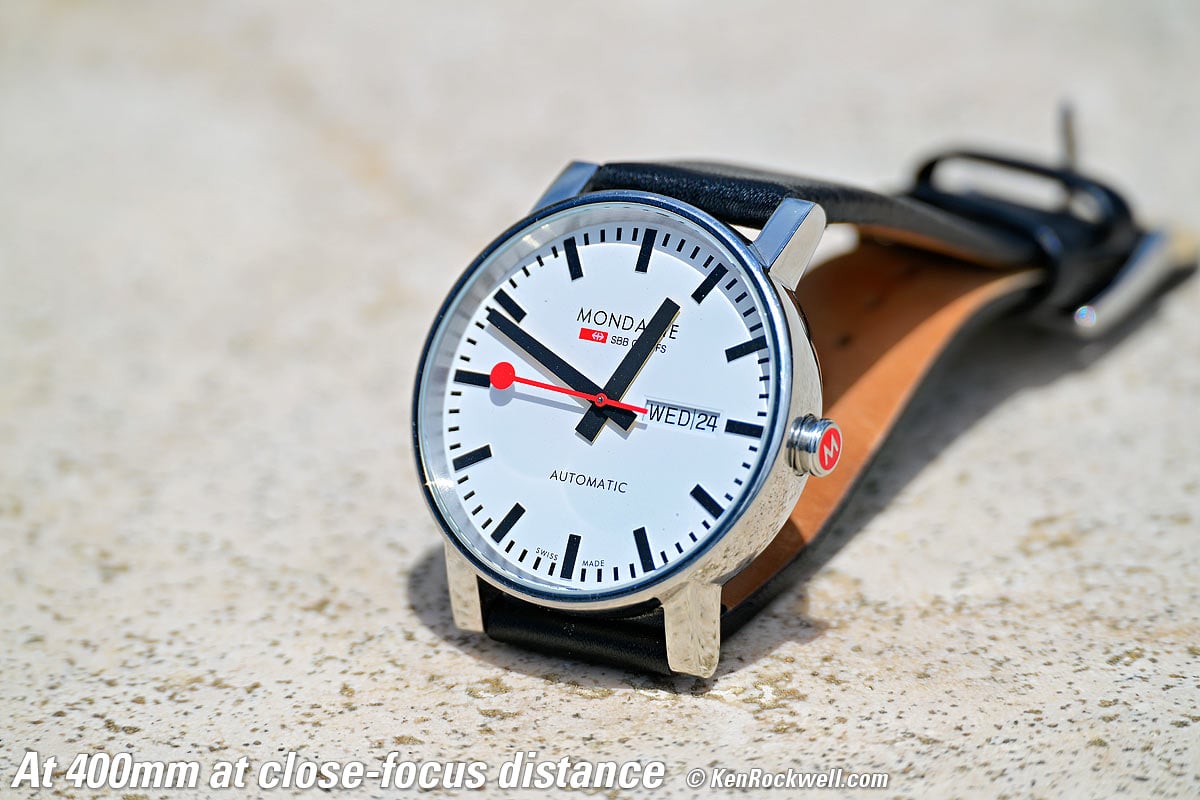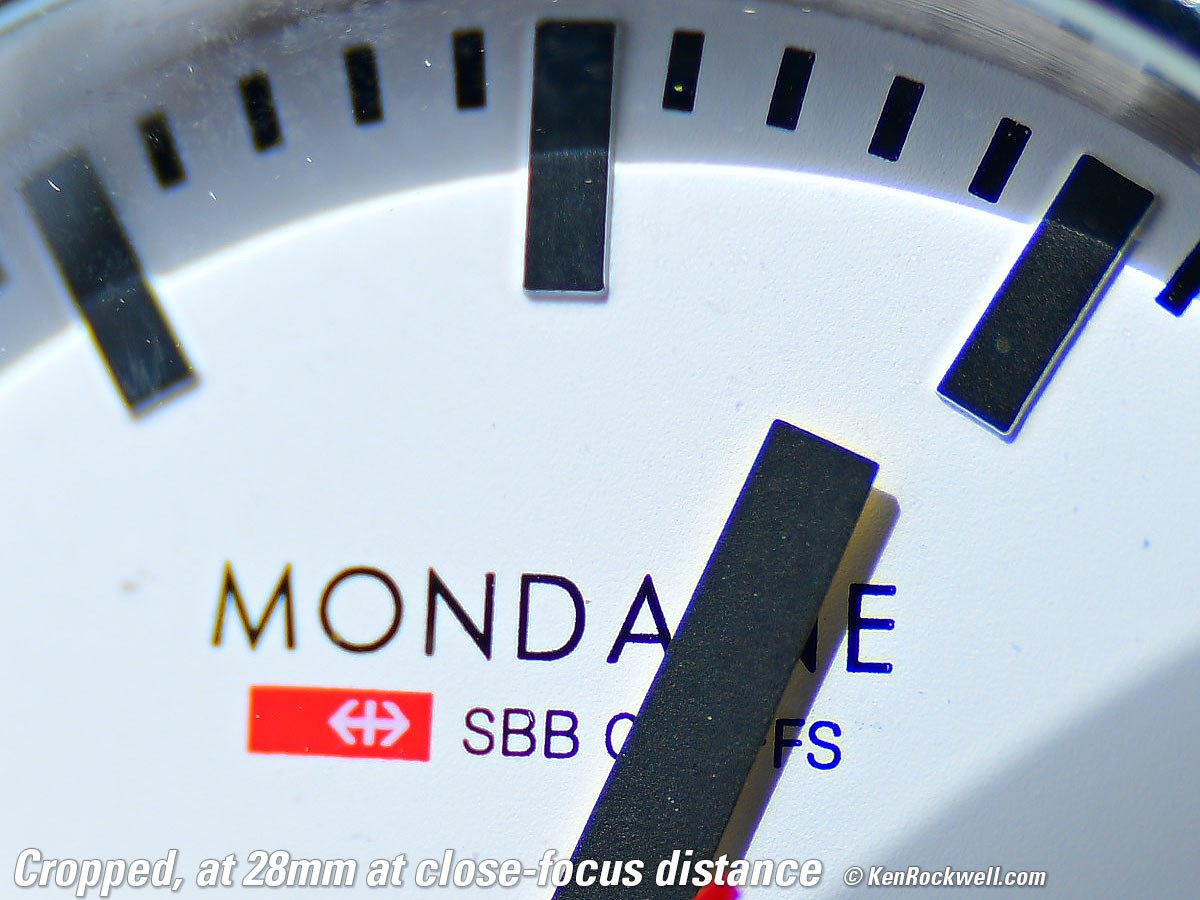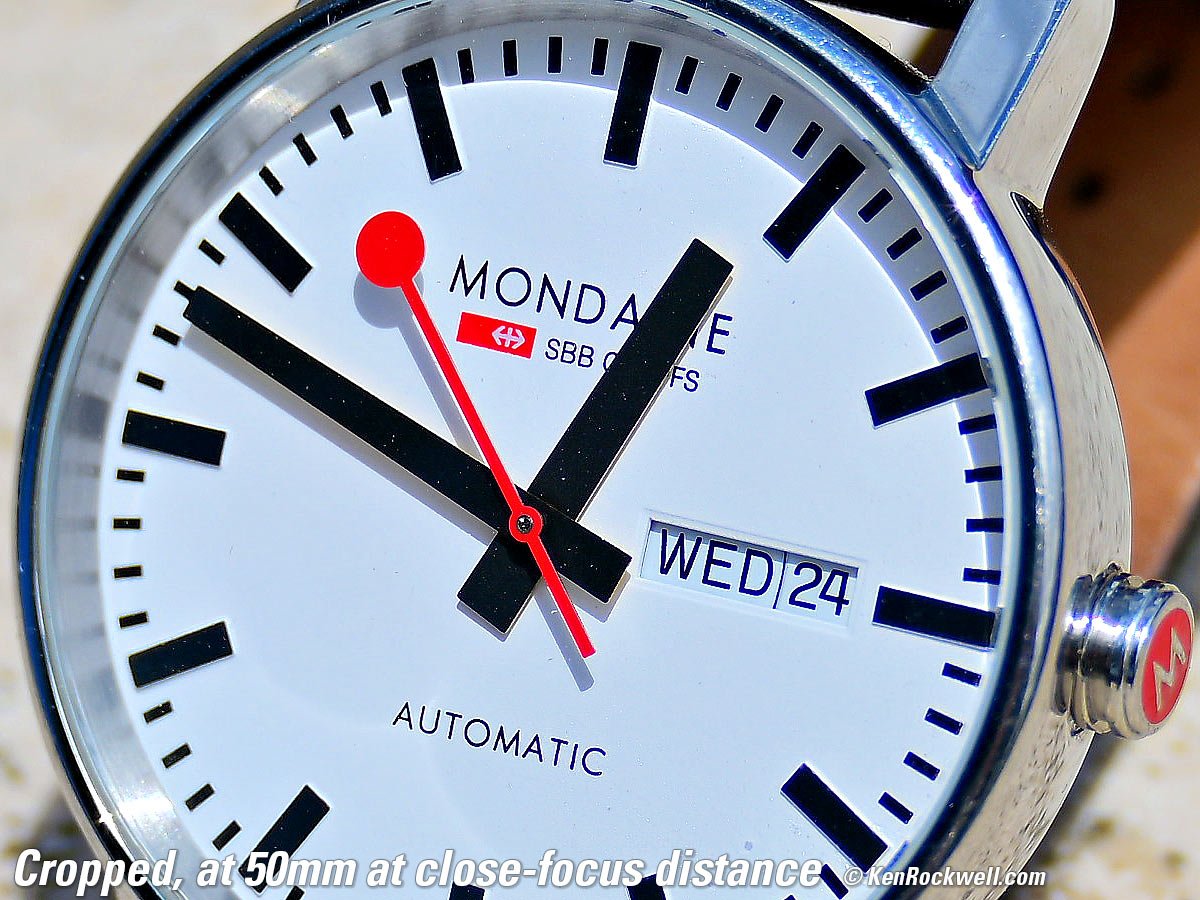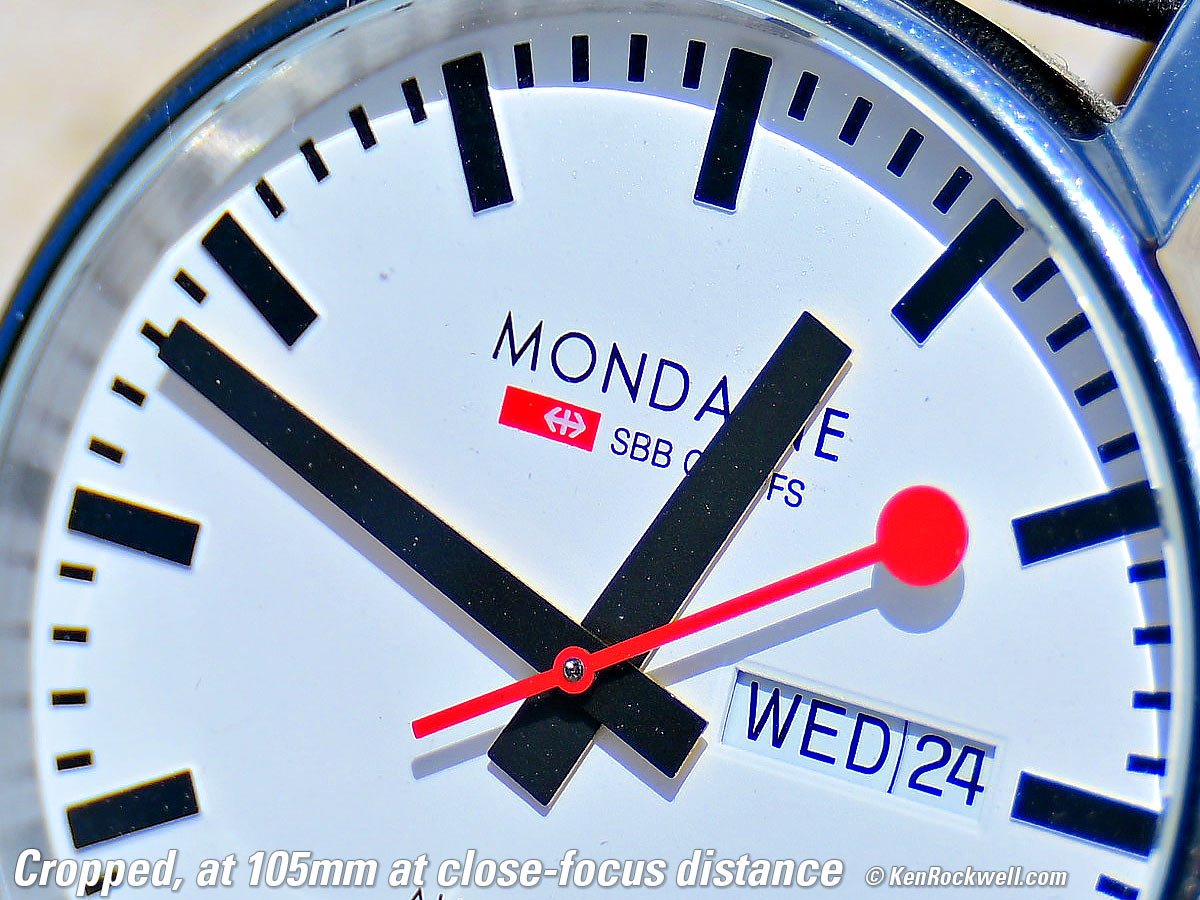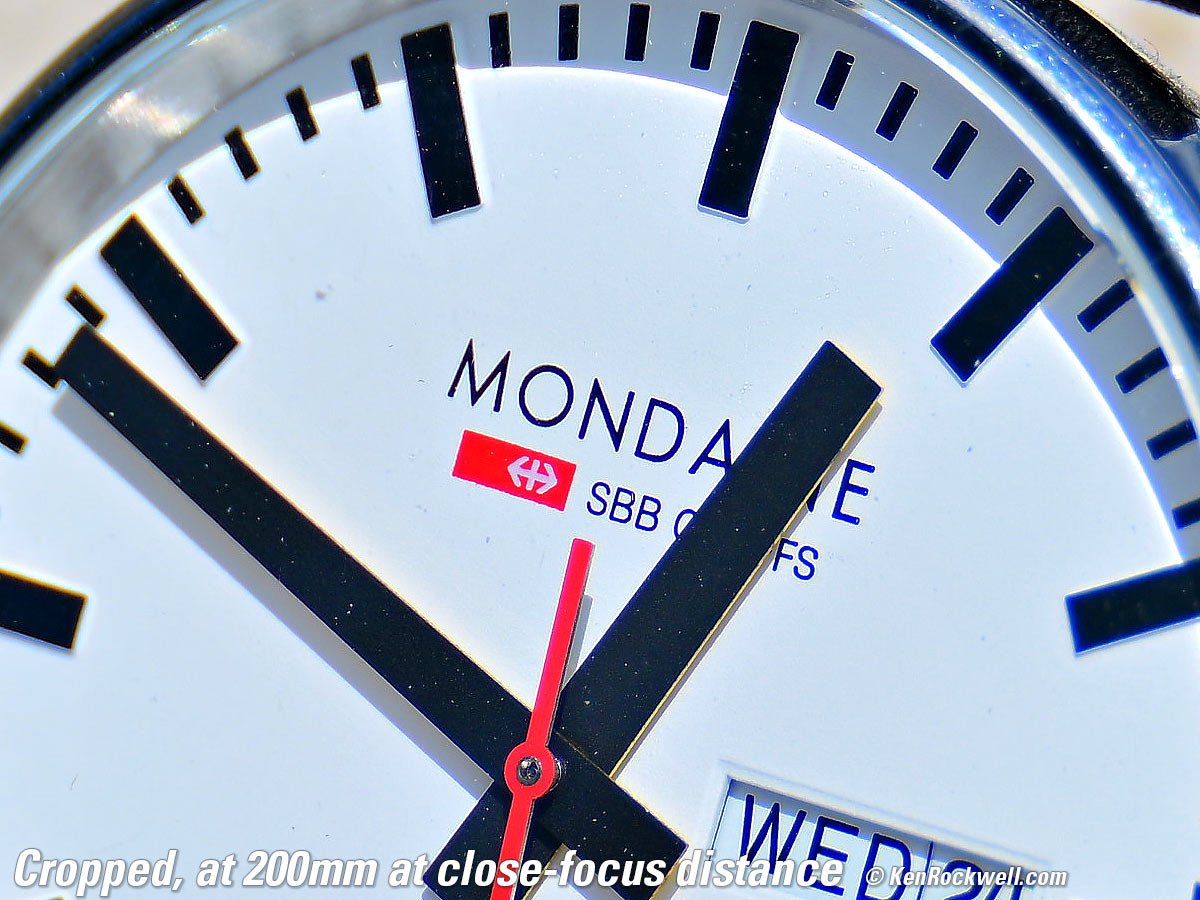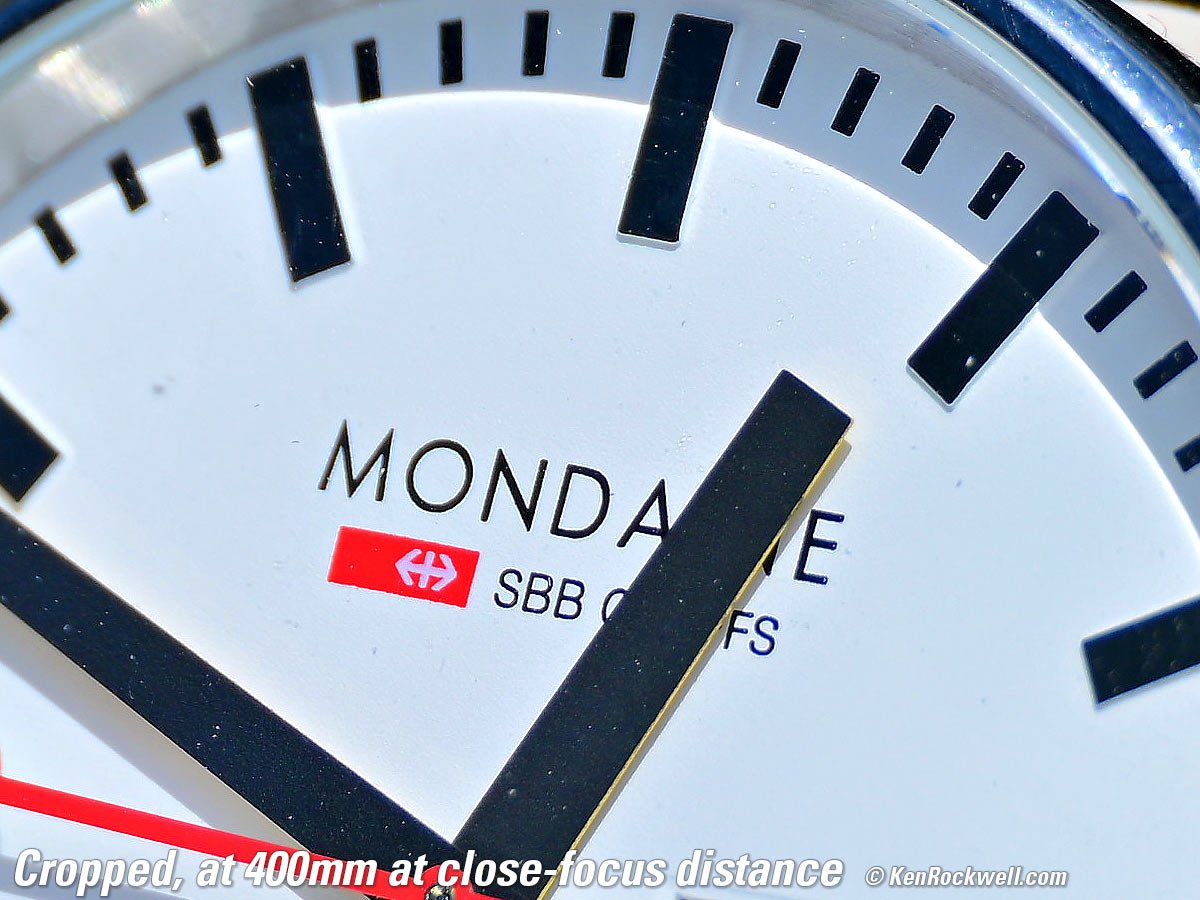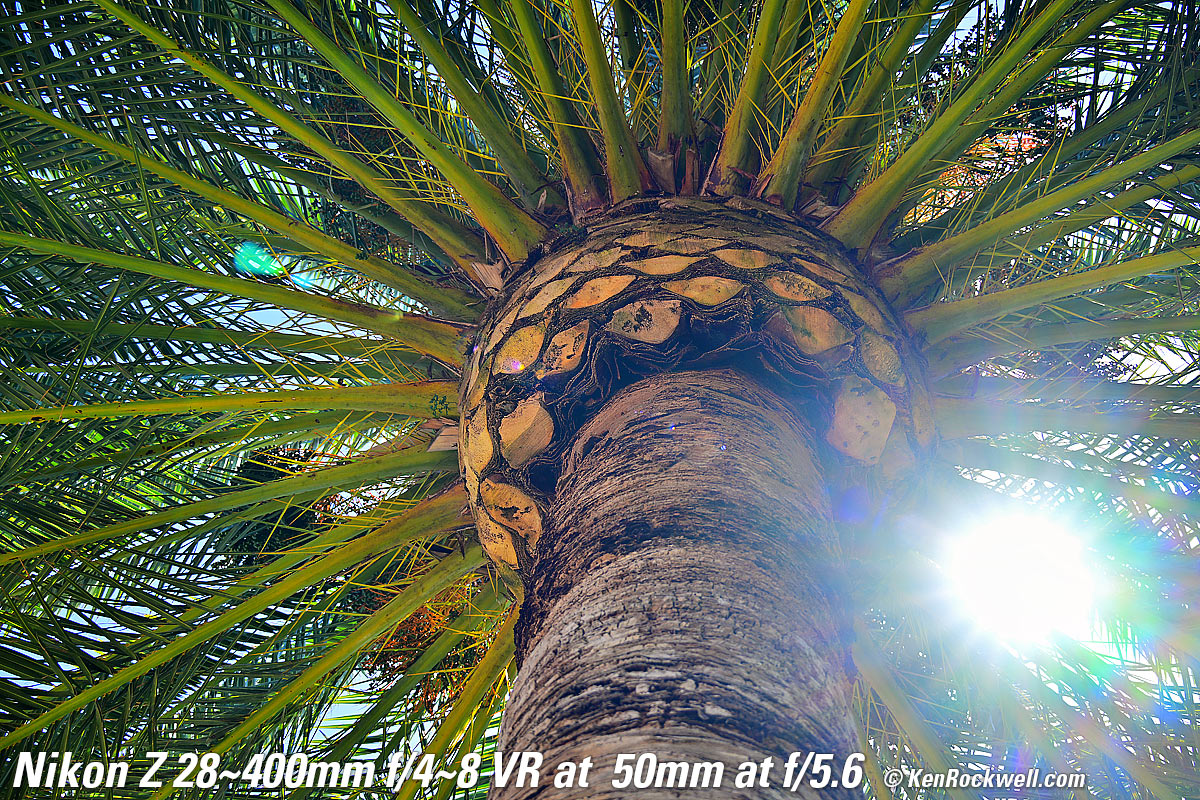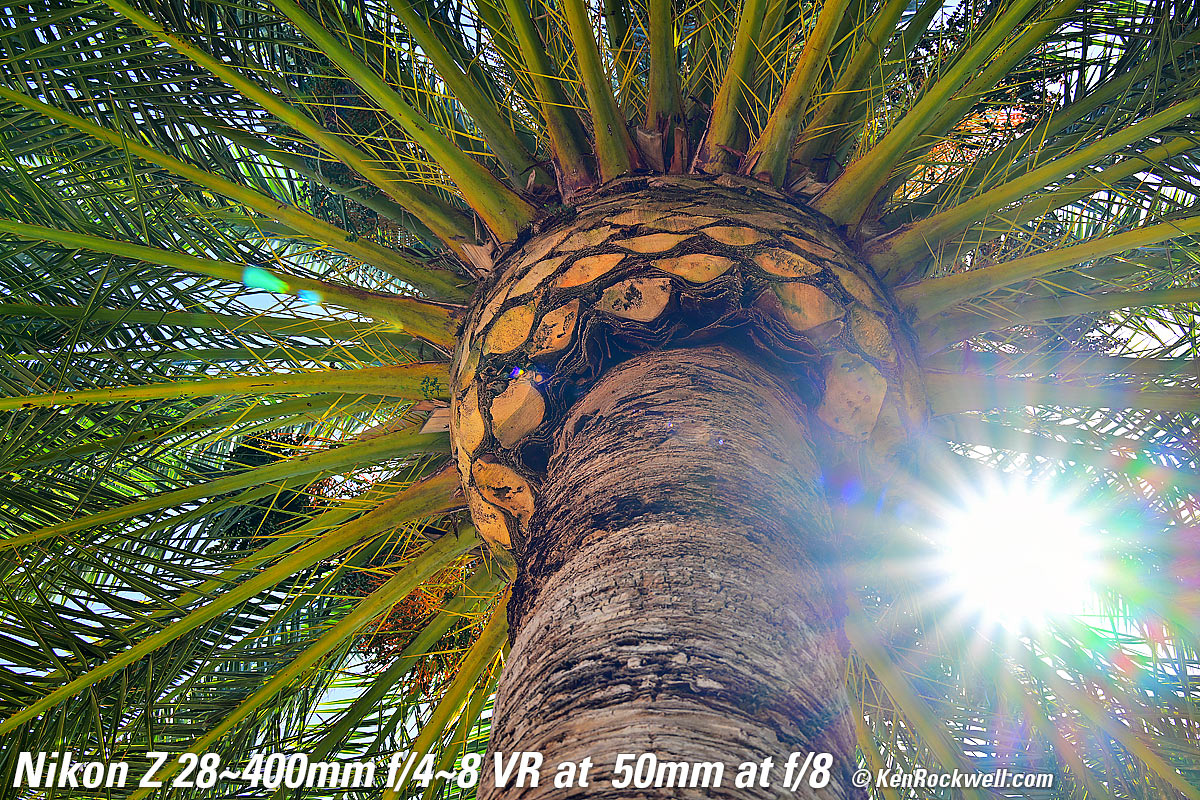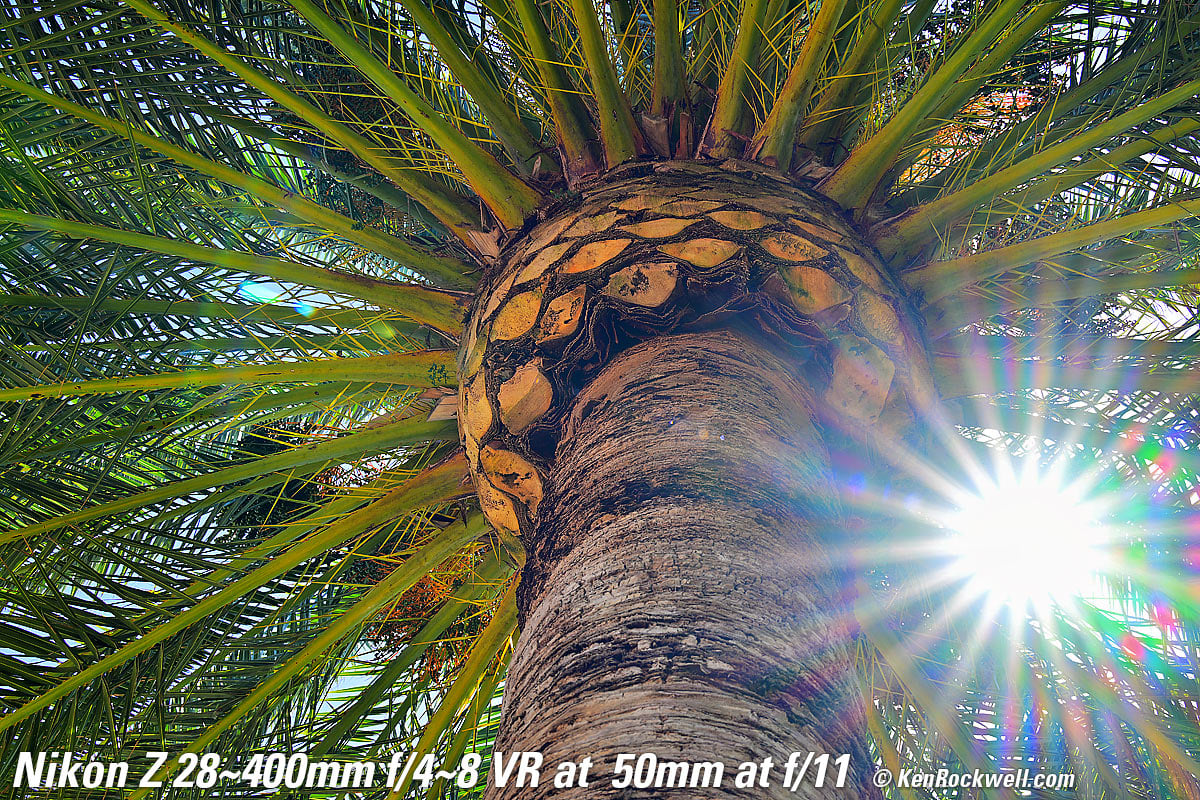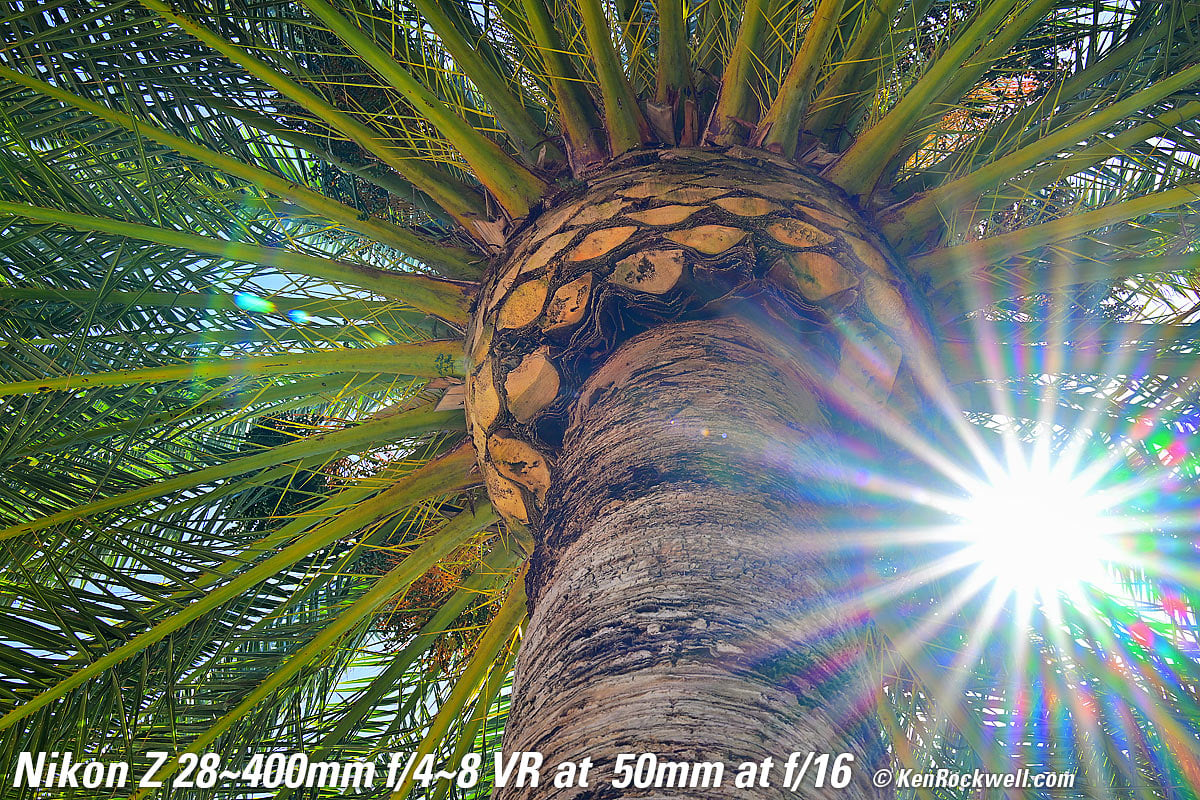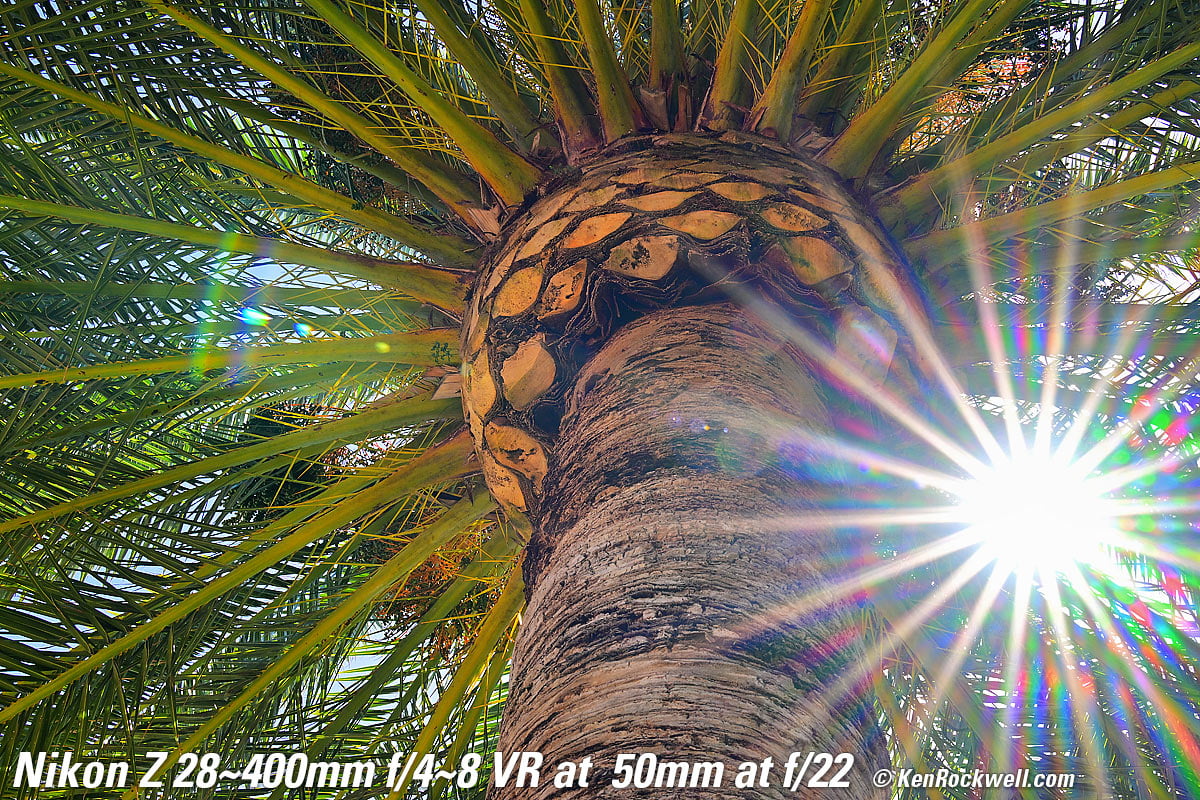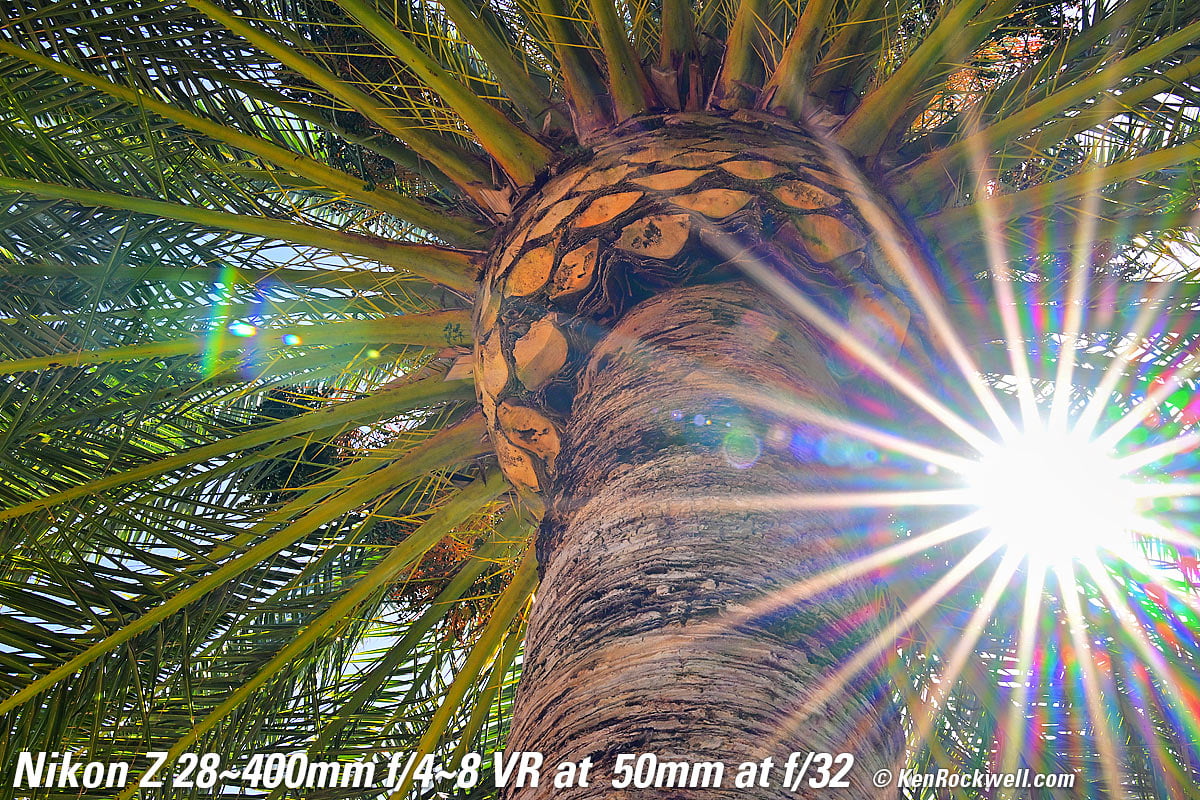Nikon Z 28-400mm VR
World's First 28~400mm Full-Frame Zoom
Introduction New Good Bad Missing
Z9 Z8 Z7 II Z6 II Zf Z7 Z6 Z5 Z fc Z50 Z30
Z System Z Lenses All Nikon Lenses Flash
Nikon: Z9 Z7 II Z6 II Z7 Z6 Z5 Z fc Z50 Z30 D6 D5 D850 D780 D750 D500 D7500 D5600 D3500 Flash Lenses
Nikon Z 28-400mm VR f/4 - f/8 (77mm filters, 25.6 oz./725g, 0.66~4'/0.2~1.2m close focus, 0.35× close focus, $1,297). bigger. I already have mine because I ordered it at B&H the day it came out. I'd also get it at Adorama, at Amazon or at Crutchfield, or used at eBay if you know How to Win at eBay. It's hard to get because it's in such great demand, so order it and be patient as I did.
This 100% all-content, junk-free website's biggest source of support is when you use those or any of these links to my personally approved sources I've used myself for way over 100 combined years when you get anything, regardless of the country in which you live — but I receive nothing for my efforts if you take the chance of getting it elsewhere. Nikon does not seal its boxes in any way, so never buy at retail or any other source not on my personally approved list since you'll have no way of knowing if you're missing accessories, getting a defective, damaged, returned, dropped, incomplete, gray-market, store demo or used lens — and my personally approved sources allow for 100% cash-back returns for at least 30 days if you don't love your new lens. I've used many of these sources since the 1970s because I can try it in my own hands and return it if I don't love it, and because they ship from secure remote warehouses where no one gets to touch your new lens before you do. Buy only from the approved sources I've used myself for decades for the best prices, service, return policies and selection.
April 2024 Better Pictures Nikon Z Z Lenses All Nikon Lenses All Nikon All Reviews
Sony vs. Nikon vs. Canon Full-Frame
Canon, Nikon, Sony, Fuji & OM SYSTEM Menu Systems Compared.
Sample Images top
Sample Images Introduction New Good Bad Missing Format Compatibility Specifications Accessories
Unboxing USA Version Performance Compared User's Guide Recommendations More
These are just snapshots; my real work is in my Gallery.
These are all shot hand-held as BASIC ★ JPGs; no tripods, NORMAL or FINE JPGs or RAW files were used or needed.
Crane, 12:16 PM, Saturday, 20 April 2024. Nikon Z8, Nikon Z 28-400mm at 400mm wide-open at f/8 hand-held at 1/400 at Auto ISO 140 (LV 14⅙), exactly as shot. bigger or camera-original © JPG file.
1,200 × 900 pixel (5× magnification) crop from above. bigger or camera-original © JPG file.
If this 1,200 × 900 pixel crop is about 3" (7.5cm) wide on your screen, then the complete image printed at this same large magnification would be about 10 × 15" (25 × 38cm).
If this 1,200 × 900 pixel crop is about 6" (15cm) wide on your screen, then the complete image printed at this same extreme magnification would be about 20 × 30" (50 × 75cm).
If this 1,200 × 900 pixel crop is about 12" (30cm) wide on your screen, then the complete image printed at this same insanely high magnification would be about 40 × 60" (1 × 1.5 meters).
Introduction top
Introduction New Good Bad Missing
|
I buy only from these approved sources. I can't vouch for ads below. |
This lens is small and light for what a landmark in zoom range it is, and of course it's sharp. My concerns are more practical: with no AF/MF switch and no VR switch it's a pain to have to go to menus to change these from shot to shot — but the Z 24-200mm VR lacks these as well.
I already have my 28-400mm because I ordered it at B&H the day it came out. I'd also get it at Adorama, at Amazon or at Crutchfield, or used at eBay if you know How to Win at eBay. It's hard to get because it's in such great demand, so order it and be patient as I did.
New intro top
 World's first 28-400mm lens.
World's first 28-400mm lens.
Good intro top
 Huge 14.3× zoom range. Replaces a wide-to-tele zoom, a regular telephoto zoom and an ultra-tele zoom, all in one easy lens.
Huge 14.3× zoom range. Replaces a wide-to-tele zoom, a regular telephoto zoom and an ultra-tele zoom, all in one easy lens.
 Small for such a long zoom.
Small for such a long zoom.
 Light for such a long zoom.
Light for such a long zoom.
 Excellent close focusing; focuses just about up to the front of the lens at 28mm.
Excellent close focusing; focuses just about up to the front of the lens at 28mm.
 Nikon claims weather sealing.
Nikon claims weather sealing.
Bad intro top
 No AF/MF switch.
No AF/MF switch.
 No VR switch.
No VR switch.
 Production dumped to China, not made domestically in Japan.
Production dumped to China, not made domestically in Japan.
Missing intro top
 No AF/MF switch.
No AF/MF switch.
 No VR switch.
No VR switch.
 Mounting index dot is the same white as everything else, so it doesn't stand out when you need to find it to mount your lens.
Mounting index dot is the same white as everything else, so it doesn't stand out when you need to find it to mount your lens.
 No focus or depth-of-field scales.
No focus or depth-of-field scales.
 No infra-red focus indices.
No infra-red focus indices.
 No focus lock buttons
No focus lock buttons
 Will not work with any teleconverters.
Will not work with any teleconverters.
Specifications top
Introduction New Good Bad Missing
I already have my 28-400mm because I ordered it at B&H the day it came out. I'd also get it at Adorama, at Amazon or at Crutchfield, or used at eBay if you know How to Win at eBay. It's hard to get because it's in such great demand, so order it and be patient as I did.
Compatibility specifications top
This lens works only on Nikon's Z-series mirrorless cameras.
It does not so much as even mount on any other camera.
It does not work with any teleconverters.
Name specifications top
Nikon calls this the NIKKOR Z 28-400mm f/4-8 VR:
NIKKOR: Nikon's brand name for almost all their lenses since 1932.
Z: For Nikon's mirrorless cameras, only.
VR: Vibration Reduction (Image Stabilization).
Nikon's Model Number: 20125.
It also has:
AF-P: Stepper (Pulse) autofocus motor: silent and ultra fast.
Aspherical: Specially curved glass elements for sharper pictures.
ED: Magic Extra-low Dispersion glass for reduced secondary chromatic aberration.
IF: Internal focusing; nothing moves externally as focused.
Ø77: 77mm filter thread.
Optics specifications top
Nikon Internal Optical Construction. Aspherical and ED elements. bigger.
21 elements in 15 groups.
4 ED elements: magic Extra-low Dispersion glass for reduced axial secondary chromatic aberration.
3 Aspherical elements.
Nikon Super Integrated multiCoating (SIC).
Diaphragm specifications top
Nikon Z 28-400mm VR f/4 - f/8. bigger.
9 rounded blades.
Electronically actuated.
Stops down to f/22 ~ f/45.
Filters specifications top
Plastic 77mm filter thread.
Angles of View specifications top
75º ~ 6⅙º diagonal on FX.
53º ~ 4º diagonal on DX.
Autofocus specifications top
No external movement as focussed, so no air or dust is sucked in.
Focus Scale specifications top
No.
Not on lens, but may be displayed in-camera.
Infinity Focus Stop specifications top
No.
You have to focus somehow to get precise focus at infinity, just like at every other distance.
Depth of Field Scale specifications top
No.
Not on lens, but may be displayed in-camera.
Infrared Focus Index specifications top
No.
Close Focus (distance from subject to image plane) specifications top
At 28mm: 0.66 feet (8" or 0.2 meters).
At 400mm: 4 feet (1.2 meters).
Maximum Reproduction Ratio specifications top
At 28mm: 1:2.9 (0.35 ×).
At 400mm: unspecified.
Reproduction Ratio Scale specifications top
No.
Not on lens, but may be displayed in-camera.
Image Stabilizer specifications top
Rated 5 stops improvement.
Caps specifications top
LC-77B front cap, included.
LF-N1 Z-mount rear cap, included.
Hood specifications top
HB-114 hood for Nikon Z 28-400mm VR f/4 - f/8. bigger.
HB-114 hood, included.
Case specifications top
Nikon CL-C2 case. This is a case? bigger.
CL-C2 "case," included.
They're kidding, right? It's just a bag, and not even padded. Geesh.
A tube sock works better.
Tripod Collar specifications top
None; this lens is so light no tripod collar is needed.
Size specifications top
3.33" ø maximum diameter × 5.57" extension from flange.
84.5 mm ø maximum diameter × 141.5 mm extension from flange.
Weight specifications top
25.6 oz. (725 g) actual measured weight.
Announced specifications top
Wednesday, 27 March 2024 at 12:17 AM, NYC time.
Promised for specifications top
18 April 2024.
Included specifications top
Lens
LC-77B front cap
LF-N1 Z-mount rear cap.
CL-C2 sack, depending on country.
Model Number specifications top
20125.
Price, U. S. A. specifications top
29 April 2024
$1,297 at B&H, at Adorama, at Amazon and at Crutchfield.
About $1,350 used at eBay if you know How to Win at eBay because it's so hard to get. You have to order it and be patient as I did.
March 2024
$1,297 at B&H and at Adorama.
Box, Nikon Z 28-400mm VR f/4 - f/8. bigger.
Box End, Nikon Z 28-400mm VR f/4 - f/8. bigger.
Performance top
Introduction New Good Bad Missing
Overall Manual Focus Distortion Ergonomics
Maximum & Minimum Apertures Mechanics
Sharpness Teleconverters Tripod Collar
I already have my 28-400mm because I ordered it at B&H the day it came out. I'd also get it at Adorama, at Amazon or at Crutchfield, or used at eBay if you know How to Win at eBay. It's hard to get because it's in such great demand, so order it and be patient as I did.
Overall performance top
The Z 28-400mm is a very compact ultra-zoom. It's easy to use, excepting its lack of AF/MF and VR switches, and offers great optics as well.
Autofocus performance top
Autofocus is fast enough at most focal lenghts, but slows down as one approaches the 400mm end.
Nikon's cameras are the biggest limitation in the autofocus system.
Focus hums slightly as the lens' internals motor around. It should be silent under most ordinary conditions.
Manual Focus performance top
Manual focusing is entirely electronic; the manual focus ring isn't connected to anything other than a digital encoder.
Just grab this electronic manual focus ring for instant manual-focus override anytime the camera is awake.
Better than any other brand, even if you're in AF-C and grab the manual-focus ring, it just swaps to manual focus instantly and stays in manual focus. Other brands will try to fight you for focus if you're in continuous AF, while this lens just does what you tell it to do. Bravo!
There is no AF/MF switch; you have to set this in a menu. Boo!
Focus Breathing performance top
Focus breathing is the image changing size as focused in and out. It's important to cinematographers that the image not breathe because it looks funny if the image changes size as focus gets pulled back and forth between actors. If the lens does this, the image "breathes" by growing and contracting slightly as the dialog goes back and forth.
The image from this lens grows slightly, and more so at longer focal lengths. Unless you're shooting at f/22 I doubt anyone would ever notice it; the defocus is usually much more than any breathing.
Distortion performance top
Distortion is corrected electronically, so it's invisible at all settings except some minor to moderate barrel distortion at 28mm, and that's after in-camera correction
If you shoot raw data rather than JPG images, whatever software you use to create visible images from raw data may or may not correct the distortion as is done in-camera as JPGs. You're on your own there; I don't bother with raw data.
While Canon's own software probably also corrects this from RAW CR3 files, be warned that other brands of raw processing software probably won't correct the distortion, and Heaven only knows what distortion you may see then.
For more critical scientific use, use these corrections in Photoshop's lens correction filter to JPG images. No, I have no idea why my Z8 doesn't correct the distortion completely.
These aren't facts or specifications, they are the results of my research that requires hours of photography and calculations on the resulting data.
On Full-Frame at 30' (10m) |
Correction factor to use with images made with correction ON in Z8 |
28mm |
+1.50 |
35mm |
+0.70 |
50mm |
+1.00 |
70mm |
+0.60 |
105mm |
±0.00 |
200mm |
±0.00 |
300mm |
±0.00 |
400mm |
±0.00 |
© 2024 KenRockwell.com. All rights reserved.
Ergonomics performance top
At 28mm
Nikon Z 28-400mm VR. bigger. |
Nikon Z 28-400mm VR. bigger. |
At 400mm
Nikon Z 28-400mm VR. bigger. |
Nikon Z 28-400mm VR. bigger. |
It's mostly zoom ring, and the focal lengths are correctly spaced for fast and precise zooming.
There are no AF/MF or VR switches; you have to set these in menus, which are real bummers as it slows down shooting.
Eyeblow performance top
This lens pumps in and out a lot, and all that air has to go somewhere.
You'll feel wind blowing out of the crack along the card door hinge as you zoom back to the wide end, at least on my Z8. That hinge isn't weather-sealed, so the air comes in and out of there as you zoom in and out.
The funny thing is that this is the first lens that pumps so much air because of its huge zoom range that much of the zoom drag comes from the air having to pump in and out through your camera. Take the lens off your camera and it zooms much more easily!
Falloff performance top
Falloff is invisible in actual use. Even wide-open at 28mm it's only visible if you really go lookign for it as I did here by shooting gray plates.
I've greatly exaggerated the falloff by shooting a gray field and placing these on a gray background; it will not look this bad in actual photos of real things:
Falloff on full-frame at infinity, correction at its default of ON:
© 2024 KenRockwell.com. All rights reserved. |
If you go out of your way to turn off the correction, or if you shoot raw data rather than JPG images and whatever software you use to create visible images from that raw data doesn't correct this as is done in-camera as JPGs, falloff is still commendably invisible except again at 28mm wide-open:
Falloff on full-frame at infinity, correction turned OFF:
© 2024 KenRockwell.com. All rights reserved. |
Filters, use with performance top
There's no need for thin filters.
I can use a fat, rotating rotating 77mm polarizer or grad filter with no vignetting at any setting on full-frame — but just one, or maybe two thin ones, at 28mm.
I can stack more and more filters as I zoom longer and longer.
Be careful at 400mm. 400mm lenses are sensitive to poorly made filters. Check any filter your hope to use with this lens for flatness. Take photos with and without the filter, or even better, just hold it over the front of one side of a pair of binoculars or a small telescope. The image should be perfectly clear with or without the filter. If the filter is even slightly unflat, the image seen through the telescope will look awful! SO long as it looks good over your scope, it will be perfect for pictures. This test instantly makes bad filters look awful.
Lateral Color Fringes performance top
There are no color fringes as shot on Nikon cameras as JPG, which by default correct for any that may be there.
If you shoot raw and then use non-manufacturer software to process that data into images then there is the possibility that there might be some, but I doubt it.
Lens Corrections performance top
If you shoot raw data rather than JPG images, whatever software you use to create visible images from raw data may or may not correct these as is done in-camera as JPGs. You're on your own there; I don't bother with raw data.
The Z9, Z8, Z7 II, Z6 II, Zf, Z7, Z6, Z5, Z fc, Z50 and Z30 correct for any or all of distortion, diffraction and falloff (vignette control). Distortion control cannot be turned off, while diffraction and falloff (vignette control) correction can be changed.
The Z9, Z8, Z7 II, Z6 II, Zf, Z7, Z6, Z5, Z fc, Z50 and Z30 always correct for lateral color fringes (lateral chromatic aberration). This is part of Nikon's secret sauce and never appears in any menu.
Macro Performance performance top
It's about as sharp at macro distances as it is at regular distances.
Close-focus and maximum reproduction ratio varies with focal length. The largest magnification is rated at 0.35× (0.42× actual measured) at 28mm, then slacks off as you zoom longer because the close-focus distance pushes-out, and then becomes almost as large again at 400mm:
Close Focus (from image plane, indicated) |
Maximum Repro Ratio, measured |
Maximum Repro Ratio, specified |
|
| 28mm | 0.66' (0.2m)* |
0.42×* |
0.35×* |
| 35mm | 1' (0.3m) |
||
| 50mm | 1.4' (0.43 m) |
0.18× |
|
| 70mm | 1.6' (0.5 m) |
||
| 105mm | 2' (0.6 m) |
0.23× |
|
| 200mm | 2.6' (0.8 m) |
0.27× |
|
| 300mm | 4' (1.2m) |
||
| 400mm | 4' (1.2m) |
0.33× |
*It gets almost right up to the front of the lens at 28mm, and gives a huge magnification on-sensor. The problem is that that close it's hard to keep light on your subject, and any three-dimensional object looks funny that close.
While rated close-focus at 28mm seems impressive, it isn't useful for actual shooting because you have to be so close to the front if the lens that it's nearly impossible to get any light on your subject:
At close-focus distance at 28mm. bigger.
Ideally we want to shoot macro at the long end of the zoom range so we can have enough working distance for good perspective rendering and not to block our own lighting. We'll see more precisely how well it works at 400mm when I get mine, but in any case it already has great close-focussing that doesn't get in the way.
Wide-Open shots of my Casio G-Shock Solar Atomic Watch
At 28mm spherochromatism and some slight defocus leads to purple fringes on some lettering.
At 50mm it gets nowhere near as close.
Click any to enlarge.
1,200 × 900 pixel (5⅙× magnification) crops from the above
The purple fringes are from defocus and spherochromatism; if in better focus this effect is reduced.
Click any to enlarge.
If these 1,200 × 900 pixel crops are about 3" (7.5cm) wide on your screen, then the complete image printed at this same magnification would be about 10½ × 15½" (0.9 × 1.3 feet or 25 × 40 cm).
If these 1,200 × 900 pixel crops are about 6" (15cm) wide on your screen, then the complete image printed at this same high magnification would be about 21 × 31" (1.7 × 2.6 feet or 50 × 80 cm).
If these 1,200 × 900 pixel crops are about 12" (30cm) wide on your screen, then the complete image printed at this same extreme magnification would be about 42 × 62" (3.5 × 5.2 feet or 1.05 × 1.6 meters).
Maximum & Minimum Apertures performance top
Maximum Aperture |
Minimum Aperture |
|
| 28mm | f/4 |
f/22 |
| 35mm | f/4.5 |
f/25 |
| 50mm | f/5.6 |
f/32 |
| 70mm | f/6 |
f/36 |
| 105mm | f/6.3 |
f/36 |
| 200mm | f/8 |
f/45 |
| 300mm | f/8 |
f/45 |
| 400mm | f/8 |
f/45 |
Mechanical Quality performance top
Nikon Z 28-400mm VR f/4 - f/8. bigger.
It's mostly plastic, with a metal mount.
Sharpness performance top
Lens sharpness has nothing to do with picture sharpness; every lens made in the past 100 years is more than sharp enough to make super-sharp pictures if you know what you're doing. The only limitation to picture sharpness is your skill as a photographer. It's the least talented who spend the most time worrying about lens sharpness and blame crummy pictures on their equipment rather than themselves. Skilled photographers make great images with whatever camera is in their hands; I've made some of my best images of all time with an irreparably broken camera! Most pixels are thrown away before you see them, but camera makers don't want you to know that.
If you're not getting ultra-sharp pictures with this, be sure not to shoot at f/11 or smaller where all lenses are softer due to diffraction, always shoot at ISO 100 or below because cameras become softer at ISO 200 and above, avoid shooting across long distances over land which can lead to atmospheric heat shimmer, be sure everything is in perfect focus, set your camera's sharpening as you want it (I set mine to the maximum) and be sure nothing is moving, either camera or subject. If you want to ensure a soft image with any lens, shoot at f/16 or smaller at ISO 1,600 or above at default sharpening in daylight of subjects at differing distances in the same image.
People worry waaaaay too much about lens sharpness. It's not 1968 anymore when lenses often weren't that sharp and there could be significant differences among them; ever since about 2010 all new lenses are all pretty much equally fantastic.
This lens is sharp, limited of course by diffraction at the smallest apertures. Avoid f/22 and smaller unless you really need them for extreme depth of field because diffraction takes its toll. See also How to Calculate the Sharpest Aperture.
Like most ultrazooms, the most difficult is staying sharp at the 400mm end.
At 400mm at f/8 it readily enlarges the effects of atmospheric heat shimmer, and almost all my shots made of things on the ground simply show these softening effects, which are no fault of the lens other than its ability to magnify this effect enough for us to see it.
Looking up, it's sharp:
Crane, 12:16 PM, Saturday, 20 April 2024. Nikon Z8, Nikon Z 28-400mm at 400mm wide-open at f/8 hand-held at 1/400 at Auto ISO 140 (LV 14⅙), exactly as shot. bigger or camera-original © JPG file.
1,200 × 900 pixel (5⅙× magnification) crop from above. bigger or camera-original © JPG file.
If this 1,200 × 900 pixel crop is about 3" (7.5cm) wide on your screen, then the complete image printed at this same large magnification would be about 10 × 15" (25 × 38cm).
If this 1,200 × 900 pixel crop is about 6" (15cm) wide on your screen, then the complete image printed at this same extreme magnification would be about 20 × 30" (50 × 75cm).
If this 1,200 × 900 pixel crop is about 12" (30cm) wide on your screen, then the complete image printed at this same insanely high magnification would be about 40 × 60" (1 × 1.5 meters).
MTF at 28mm at f/4. |
MTF at 400mm at f/8. |
Spherochromatism performance top
Spherochromatism, also called secondary spherical chromatic aberration or "color bokeh," is an advanced form of spherical and chromatic aberration in a different dimension than lateral chromatic aberration. It happens mostly in fast normal and tele lenses when spherical aberration at the ends of the color spectrum are corrected differently than in the middle of the spectrum. Spherochromatism can cause colored fringes on out-of-focus highlights, usually seen as green fringes on backgrounds and magenta fringes on foregrounds. Spherochromatism is common in fast lenses of moderate focal length when shooting contrasty items at full aperture. It goes away as stopped down.
It has a small amount of spherochromatism.
Here are shots of a slightly angled Mondaine A132.30348.11SBB at close-focus distance wide-open, 24 April 2024:
A slightly angled Mondaine A132.30348.11SBB at close-focus distance wide-open, 24 April 2024. Click any to enlarge.
Here are 1,200 × 900 pixel (5⅙× magnification) crops from the above:
1,200 × 900 pixel (5⅙× magnification) crops from above. Click any to enlarge.
If these 1,200 × 900 pixel crops are about 3" (7.5cm) wide on your screen, then the complete image printed at this same magnification would be about 10½ × 15½" (0.9 × 1.3 feet or 25 × 40 cm).
If these 1,200 × 900 pixel crops are about 6" (15cm) wide on your screen, then the complete image printed at this same high magnification would be about 21 × 31" (1.7 × 2.6 feet or 50 × 80 cm).
If these 1,200 × 900 pixel crops are about 12" (30cm) wide on your screen, then the complete image printed at this same extreme magnification would be about 42 × 62" (3.5 × 5.2 feet or 1.05 × 1.6 meters).
Sunstars performance top
With a 9-bladed rounded diaphragm, I get excellent 18-point sunstars on brilliant points of light mostly at the smallest apertures.
Ignore the crazy rainbow dots at small apertures; these are sensor artifacts caused by taking a picture directly of the sun and exposing for the dark underside of a huge palm tree, and using that same palm tree to hide the sky to accentuate the stars.
Click any to enlarge:
Click any to enlarge.
Teleconverters performance top
NO teleconverters work with this lens. The rear elements come too close to the mount to allow converters to poke up into the lens as they do with the other teles.
Tripod Collar performance top
There's no tripod collar available or needed.
This lens has a long focal length, but it's so light no collar is needed.
Compared top
Introduction New Good Bad Missing
I already have my 28-400mm because I ordered it at B&H the day it came out. I'd also get it at Adorama, at Amazon or at Crutchfield, or used at eBay if you know How to Win at eBay. It's hard to get because it's in such great demand, so order it and be patient as I did.
This lens is so small and light that it's smaller and lighter than the ultralight Z 70-180mm f/2.8!
Currently my favorite Nikon Lens is the Z 24-200mm VR, and I expect that this may replace it for me. It's all a question of how long do I want to go versus having to carry extra weight everywhere. To me 28mm and 24mm are the same.
|
|||
Introduced |
12 February 2020 |
27 March 2024 |
21 June 2023 |
Maximum Apertures |
f/4 ~ f/6.3 |
f/4 ~ f/8 |
f/2.8 |
Filter |
|||
Close Focus |
1.6' (0.5m) at 24mm 2.3' (0.7m) at 200mm |
0.66' (8" or 0.2m) at 28mm 4' (1.2m) at 400mm |
0.9' (0.27m) at 70mm 2.8' (0.85m) at 180mm |
Max. Repro. Ratio |
0.28× at 200mm |
0.35× at 28mm |
0.48× at 70mm |
AF/MF Switch |
No |
No |
No |
VR Stabilization |
Yes |
Yes |
No |
VR Switch |
No |
No |
No |
Length (at wide) |
4.5" (114mm) |
5.6" (142mm) |
5.9" (151mm) |
Weight |
19.9 oz. (565g) |
25.6 oz. (725g) |
28.0 oz. (795g) |
Price, 3/2024 |
Recommendations top
Introduction New Good Bad Missing
I already have my 28-400mm because I ordered it at B&H the day it came out. I'd also get it at Adorama, at Amazon or at Crutchfield, or used at eBay if you know How to Win at eBay. It's hard to get because it's in such great demand, so order it and be patient as I did.
It's not 2004 anymore. Today ultrazoom lenses like this give great performance on mirrorless unlike anything we've seen before on DSLRs. Hit the road, go on your safari or cruise ship vacation with just this one lens and you're set — and will get far better long shots than you ever could get with any iPhone.
I use a clear (UV) protective filter instead of a cap (exactly like an iPhone) so I'm always ready to shoot instantly. I only use a cap when I throw this in a bag with other gear without padding — which is never. The UV filter never gets in the way, and never gets lost, either.
The best protective filter is the 77mm Hoya multicoated HD3 UV which uses hardened glass and repels dirt and fingerprints.
For less money, the the B+W multicoated 010 MRC is an excellent filter, as is the 77mm Nikon Clear (NC - UV) and the basic multicoated 77mm Hoya UV filter, but the Hoya HD3 is the toughest and the best.
Filters last a lifetime, so you may as well get the best. The Hoya HD3 stays cleaner than the others since it repels oil and dirt, and will outlast this lens.
All these filters are just as sharp and take the same pictures, the difference is how much abuse they'll take and stay clean and stay in one piece. Since filters last a lifetime or more, there's no reason not to buy the best as it will last you for the next 40 years. Filters aren't throwaways like digital cameras which we replace every few years, like it or not. I'm still using filters I bought back in the 1970s!
I already have my 28-400mm because I ordered it at B&H the day it came out. I'd also get it at Adorama, at Amazon or at Crutchfield, or used at eBay if you know How to Win at eBay. It's hard to get because it's in such great demand, so order it and be patient as I did.
This 100% all-content, junk-free website's biggest source of support is when you use those or any of these links to my personally approved sources I've used myself for way over 100 combined years when you get anything, regardless of the country in which you live — but I receive nothing for my efforts if you take the chance of getting it elsewhere. Nikon does not seal its boxes in any way, so never buy at retail or any other source not on my personally approved list since you'll have no way of knowing if you're missing accessories, getting a defective, damaged, returned, dropped, incomplete, gray-market, store demo or used lens — and my personally approved sources allow for 100% cash-back returns for at least 30 days if you don't love your new lens. I've used many of these sources since the 1970s because I can try it in my own hands and return it if I don't love it, and because they ship from secure remote warehouses where no one gets to touch your new lens before you do. Buy only from the approved sources I've used myself for decades for the best prices, service, return policies and selection.
Thanks for helping me help you!
Ken.
© Ken Rockwell. All rights reserved. Tous droits réservés. Alle Rechte vorbehalten. Alla rättigheter förbehållna. Toate drepturile rezervate. Ken Rockwell® is a registered trademark.
Help Me Help You top
I support my growing family through this website, as crazy as it might seem.
The biggest help is when you use any of these links when you get anything. It costs you nothing, and is this site's, and thus my family's, biggest source of support. These places always have the best prices and service, which is why I've used them since before this website existed. I recommend them all personally.
If you find this page as helpful as a book you might have had to buy or a workshop you may have had to take, feel free to help me continue helping everyone.
If you've gotten your gear through one of my links or helped otherwise, you're family. It's great people like you who allow me to keep adding to this site full-time. Thanks!
If you haven't helped yet, please do, and consider helping me with a gift of $5.00.
As this page is copyrighted and formally registered, it is unlawful to make copies, especially in the form of printouts for personal use. If you wish to make a printout for personal use, you are granted one-time permission only if you PayPal me $5.00 per printout or part thereof. Thank you!
Thanks for reading!
Ken.
